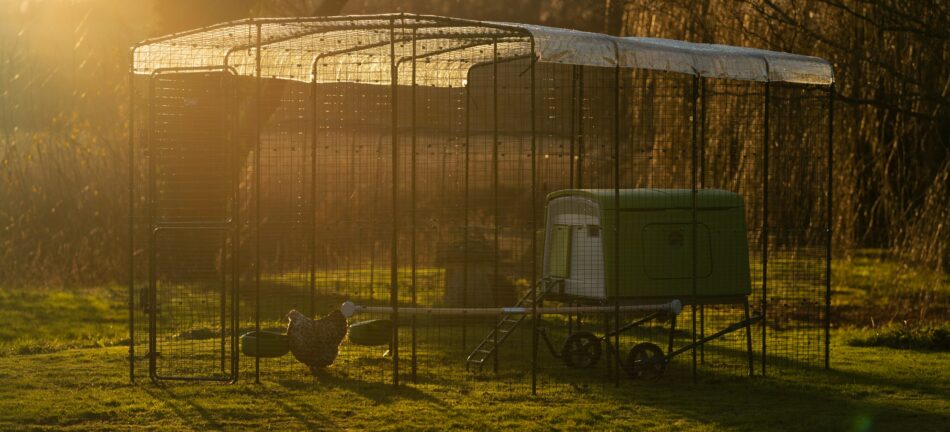
There are many references to spring and chickens, but hens are not exclusive to just one season. In fact, there are some breeds of chickens that prefer autumn and its cooler temperatures. But, no matter if you have spring chickens or an autumn flock, we’ve got the products to keep your hens happy all year long.
Should you get chickens in autumn?
Autumn and spring have a lot in common: moderate temperatures, change in the amounts of daylight and vegetation, and a great opportunity to try something new. Because of these ideal conditions, autumn is an excellent time to consider getting chickens. Here are some reasons why autumn may actually be better than spring for adding chickens to your garden or existing flock:
- Cooler temperatures mean less stress for hens
- Shorter days encourage hens to learn their roost and wake routines quickly
- Less vegetation means more treats and opportunities for you to bond with your new hens
There’s also shorter, less dense grass in the autumn — giving you the perfect opportunity to practice manoeuvring your chicken tractor or to position your chicken coop.
Why do some chicken breeds do better in autumn?
What makes one breed of hen better than the next when it comes to seasonal changes and cooler temperatures? Hens have advantages that are displayed in the way they are built that will clue you in as to how likely they are to be a fan of autumn. Their feathering, size, and even their combs and wattles are good indicators of if your hen is hardy in autumn.
Since chickens release heat through their combs and wattles, breeds with larger head adornments tend to do best in the heat. Conversely, hens with smaller combs and wattles are less likely to experience frostbite in the winter. Lean chickens fare better in the heat, and heavy hens weather the winter with ease. And so, in order to have a well-rounded chicken that will best tolerate the changing of the seasons, a balance must be found.
We’ve outlined some breeds of chickens that thrive in autumn because of their general hardiness in all temperatures. Not all chicken keepers will experience cold temperatures during autumn, just like not all flocks are frozen in autumn. The best hens to keep in the autumn are those that are both cold and heat-tolerant.
Plymouth Rocks
Plymouth Rock chickens are known for their hardiness in most temperatures. They have moderate-sized combs and while they’re considered a heavy breed, they aren’t oversized. Plymouth Rocks are excellent layers of large brown eggs, and have a long lifespan of up to 10-12 years. Plymouth Rocks are typically “barred”, meaning their feathers are striped in pattern. Their black and white colouring will make them easy to spot among the autumn foliage.
Possibly the most popular breed of chicken, Rhode Island Reds are hardy in just about every climate. They’re a dual-purpose breed (bred for both meat and eggs) but aren’t as heavy as hens bred exclusively for meat. They have moderate-sized combs and wattles, and are excellent layers of brown eggs. Rhode Island Reds are active, making them great choices for autumn insect control.
Brahmas
They may be large, but Brahmas are surprisingly adaptable to both hot and cold climates. Their dense feathers keep them warm in cooler temperatures, and as long as they have access to cool water and shade, they will fare just fine as the weather warms up. Their legs are well protected by their feathers, but it’s important not to let them stand in mud — it can cake in their fluffy feet and lead to soreness. Due to their size, Brahmas won’t hop your garden fence to sample your autumn harvest.
Australorps
Australorps are essentially smaller versions of Orpingtons, but with just as impressive laying ability, with the world record of 364 eggs in 365 days being set by an Australorp hen. In addition to their prolific egg-laying, they are both heat and cold-hardy, adjusting to each season with ease. Their unique “beetle black” colouring sports a green hue when their feathers are fresh from their autumn moulting cycle.
Easter Eggers
Not an officially recognized breed, Easter Eggers are the result of crossing an Araucana and any other breed of chicken that lays brown eggs. The result is a rainbow of possibilities for eggshell colour: from blue, green, and even pink-coloured eggs. Because they can vary widely in appearance and build, Easter Eggers that are best suited to all seasons are of medium build with small or medium-sized wattles and combs. That being said, hybrid breeds are known for their health and hardiness — making them an excellent choice to start with in the autumn.
Orpingtons
Orpingtons are generally recognized as a cold-hardy breed, but in recent years have gained a reputation for being tolerant of most weather. They may be on the heavier side, but their large combs and wattles help disperse heat to keep them cool in the summer months. Their head adornments may need some Vaseline in the winter to keep them from becoming frostbitten, but since Orpingtons are known as the “lapdogs” of chicken breeds, it should be an easy task. Their rich colours are a perfect complement to an autumn palette.
Flock-raising in the autumn
Regardless of breed, all chickens need a sturdy, comfortable home to thrive in the autumn. The cooler temperatures, changes in vegetation, and shorter days all affect how your hens feel and behave. During this particular change in the seasons, you may be wondering how chicken keepers can prepare for autumn. Some things to keep in mind are:
Preparing your chickens for autumn can be an enjoyable task when you have the right setup. An easy-to-clean chicken coop goes a long way in helping to prepare for autumn, allowing you to get it fresh and clean for the new season with minimal time and effort.
Chickens scratching through your freshly raked leaf piles? Chicken fencing is a fast and easy solution to keeping your flocks from reaching certain areas. Omlet’s chicken fencing comes in multiple lengths, and can be arranged in any shape you desire. And, when the seasons change once again, the poles are easy to pick up and move to create a new area for your hens.
Omlet and your autumn flock
Omlet supplies chicken keepers all over the world with products that not only last through the seasons, but provide ultimate support and comfort to chickens and their raisers. Our Eglu Cube chicken coop, chicken toys, and chicken fencing will meet all of your hens’ needs this autumn – and make this season, and every season, the best experience with your flock.
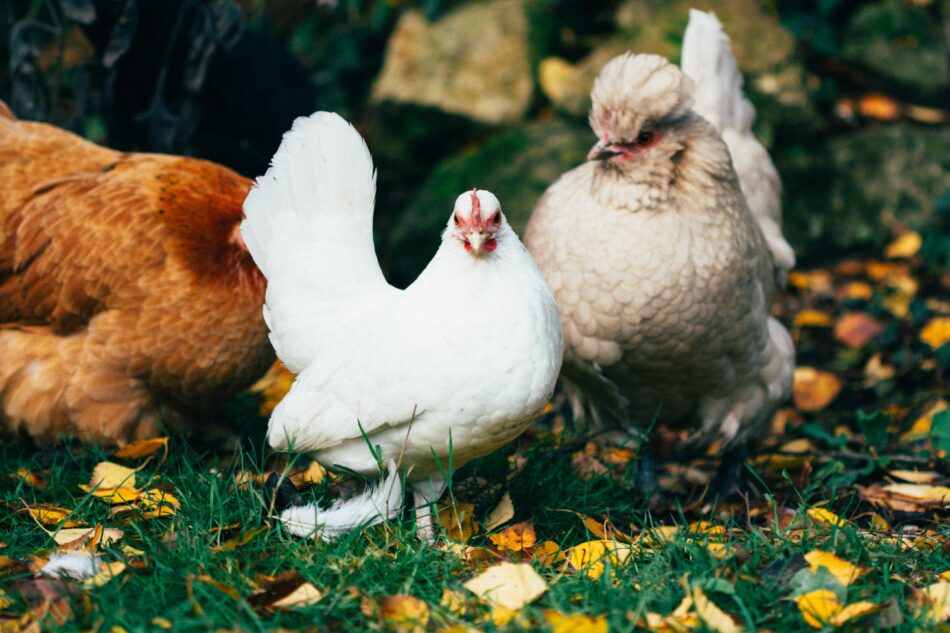

This entry was posted in Chickens
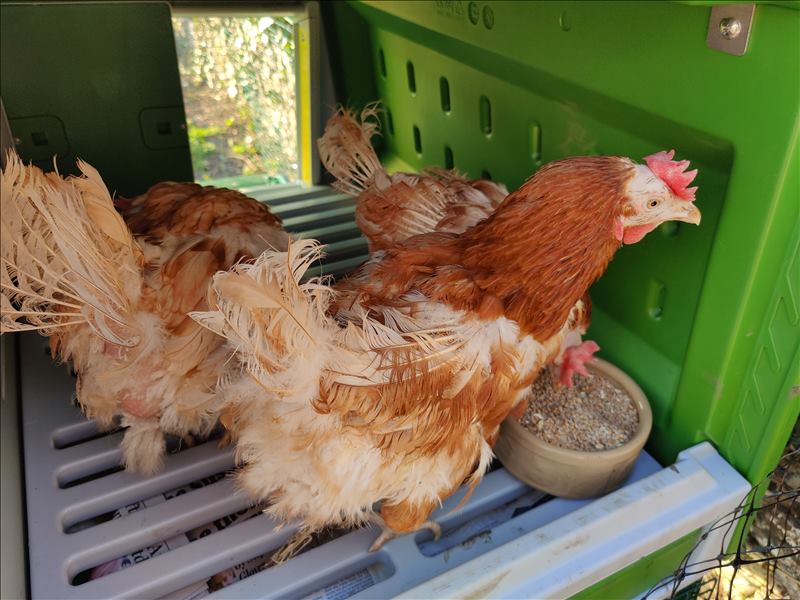
Have you considered rescuing chickens? Whether you’re just starting out with a flock, or growing an established one, adopting hens can be an emotionally rewarding experience. Hens can be in need of rescue for a number of reasons: owner surrender or confiscation, retiring breeding or laying hens, or chickens with special needs – there are chickens in search of their forever homes. We’ll share our 6 top tips for rescuing hens, and show you how Omlet can support them, and you, in the journey.
1. Find the perfect chicken coop
Creating the perfect setup for rescue hens is essential in helping them adjust to their forever home. Hens in need of rescuing may have been confiscated by law enforcement due to neglect or unsuitable living situations or may be leaving a noisy egg production facility. No matter what their story may be, all rescued hens will be in desperate need of a safe place to land.
Having an Eglu Cube chicken coop ready for your hens’ arrival will provide them with peace and comfort from the start. With its elevated design and secluded egg-laying area, hens can find rest in the shade and a secluded place to lay their eggs privately. The attached run offers space to peck at the grass – which may be something rescued hens have never experienced before. The Eglu Cube is also available as a chicken tractor to offer your newly rescued hens fresh patches of grass and a new selection of insects to munch on.
Adding an automatic chicken coop door will help your hens feel even more secure overnight. The gently closing door will tuck them in tight and keep potentially stressful sights and sounds from keeping them awake. And, with the ability to open and close on a light or timed schedule, rescued hens can seize the day at the crack of dawn while you sleep in.
2. Give them plenty of space
Space is not something generally afforded to hens that are coming from less-than-ideal living conditions. Whether they’ve been crowded or caged, your newly rescued hens will appreciate having some room to spread out. And, as their new owner and forever-home-provider, you’ll want to spend time with them in their setup.
Our Walk In Chicken Run gives rescued hens the space they deserve, while giving you the opportunity to spend time with them. The convenient and secure stable-style doors let you access your hens with ease, and the fully enclosed run keeps your hens safe from predators. The anti-dig skirting helps prevent predators like foxes from tunnelling in, and the roof panels keep aerial predators away from your flock.
Customise their walk in run with chicken perches, the PoleTree customisable chicken perch, or Freestanding Chicken Perch for unparalleled perching opportunities. Perches or chicken toys and the enrichment they provide are probably elements that rescued hens have never encountered before, but are excellent ways to let your new flock members know that they are loved and safe in their new home.
3. Allow them to settle
Depending on their previous living conditions, rescued hens may take longer to settle into their new homes than those raised in ideal situations. At first, they may be distrustful of humans – either from negative experiences or lack of contact. Give them plenty of time to become used to seeing you. With patience and routine, your rescued hens will soon figure out that you mean them no harm.
As tempting as it may be to get to know your new chickens, don’t attempt to handle or pet rescued hens for the first week or two. Chickens make great family pets, but children should be taught how to handle hens properly and to respect their space when needed. Rescued hens will be overwhelmed enough trying to get used to their new surroundings, so incorporating unfamiliar physical contact may be too much for them. Instead, try to sit quietly with your flock while they eat or peck in the grass. Speak softly to them to get them used to your voice. Over time, you can offer treats or scratch grains by hand – just make sure to let your hens come to you.
4. Understand the pecking order
Chickens are social animals that have a hierarchy within their flocks known as the “pecking order.” To new chicken keepers, the act of establishing this pecking order may be confusing or even concerning to witness. To understand the pecking order in your hens, you’ll need to watch them closely when introducing them – both to each other and to a new home. Normal behaviours for chickens establishing a pecking order include:
- Raising the feathers around their neck
- Squaring off with each other through posturing or staring
- Squawking or clucking at each other
- Brief scuffles that include sparring and/or feather pulling
Every flock has a pecking order, which can be challenged periodically even once it’s established. It’s normal to see minor and short-lived disagreements within an established flock, but chickens should be separated from each other if:
- Physical altercations occur more often than once or twice a day for consecutive days
- Bleeding or extreme feather pulling occurs
- Dominate hens are keeping other hens from coming into the coop to roost or lay eggs (even the “top ranking” hens should see that the lowest ranking hens have a safe place to sleep and lay)
- Flock members are keeping others from eating or drinking
5. Keep an eye on their health
If you’re adding rescued hens to your own backyard flock, you’ll want to be absolutely sure they’re healthy first. All new chickens should be quarantined away from your flock for 14 days to make sure they don’t have anything contagious. Consider having a secondary chicken setup such as the Eglu Go chicken coop to quarantine new hens, or to separate ill or fighting flockmates.
Even if your rescued hens are your first flock, you’ll want to give your chickens a health check before releasing them into their setup. Once they’re in their forever home, keep a close eye on them to make sure they are eating, drinking, and acting normally.
The appearance of rescued hens varies, but some common ailments seen in rescued hens include:
- Dull or missing feathers
- Clear, thin discharge from the eyes or nose
- Irregular gait or hesitant to walk much (usually due to being confined in a wire cage – their feet may be sore and their legs weak)
These minor discomforts should resolve within a week or two after eating a nutritious diet. If your hens don’t improve, or get worse, be sure to call your veterinarian.
6. Provide them with the right diet
Feeding your hens a nutrient-dense diet will help them feel and look their best. If they are a laying breed of chicken, be sure to feed them quality laying pellets containing 16-18% protein. Your hens can have feed left out for them all day – even rescued hens that may have been deprived of food will not overeat. It’s also helpful to feed chicken supplements to help hens bounce back from stress. Protein-rich treats will help hens feel more energised – and are also a great bargaining chip when it comes to winning their trust.
As with any flock, make sure rescued hens have unlimited access to fresh water. Adding a small amount of apple cider vinegar to their water will help boost your hens’ immune system and help them grow healthy feathers. You can also toss herbs like fresh oregano into their water or feed for an added immunity boost.
Where to rescue hens
There are various resources when it comes to adopting rescued hens. A great place to start would be the BHWT. You can get in touch with the BHWT via their website to find out more on how you can help rescue hens in the UK.
Omlet and your rescue hens
Adopting an animal in need is a beautiful thing. Rescuing hens from dire situations or temporary care and bringing them to their forever homes is a balm for both chickens and their keepers. Omlet’s Eglu Cube, Walk In Chicken Run, and Autodoor will help your rescued hens feel safe and secure from the first moment in their new setup. A difficult living situation can be turned into a distant memory with your love and care, and with our chicken products that are designed to help hens live their best lives.
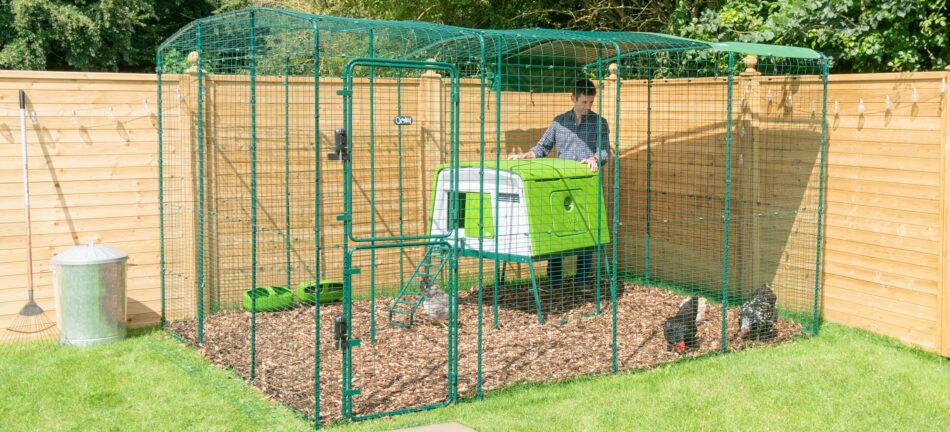

This entry was posted in Chickens
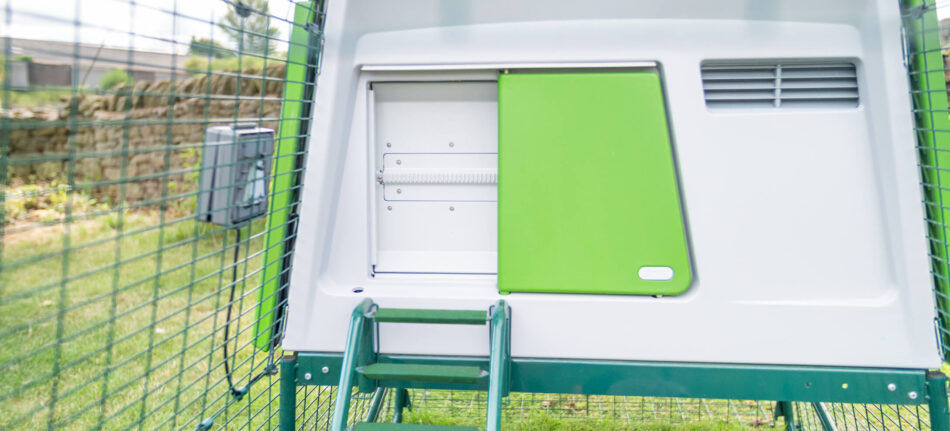
The best automatic chicken coop door is one that serves multiple purposes. One that is programmable to fit your schedule, provides a layer of protection from predators, and opens horizontally with built-in safety sensors. Read on to see how an Autodoor can revolutionize your chicken-keeping routine.
Why your chicken coop needs an automatic door
An automatic chicken coop door turns your ordinary coop into a technologically advanced smart hen house. Like a personal chicken coop concierge, the best automatic chicken coop door keeps your hens on schedule and protected while they roost. The addition of an Autodoor will:
There are many different types of automatic chicken coop doors, but there’s a clear choice for the best option when it comes to flock comfort and safety.
The Automatic Chicken Coop Door from Omlet
The Autodoor by Omlet has been thoughtfully designed. Made of heavy-duty, rot and rust-free materials, it’s easy to clean and will last a lifetime. The ingenious horizontally opening screw-style gearing makes it incredibly difficult for predators to pry open. Omlet’s Autodoor also increases the insulating effects of our Eglu Cube chicken coop, and is designed to integrate into it seamlessly without having to remove the existing door. The Autodoor can also be installed on an existing wooden chicken coop, Omlet chicken runs, or on traditional chicken wire runs.
Light sensors for dawn/dusk automation
Want to sleep in or stay out late, but still have your flock tended to? The Autodoor can keep your hens on schedule based on the sun. And, since chickens seek out their roosting space based on the amount of daylight, you’ll never need to worry about changing the Autodoor’s settings when winter comes around. The various hours of sunlight during the year will prompt the Autodoor to close at the desired light level – no matter the season. And, the sophisticated Autodoor takes into account storms or overcast conditions, ensuring the door doesn’t close during brief fluctuations in lighting.
Set your own schedule
Some flocks roost at the same time each day rather than waiting for the sun to go down. If you have hens that prefer to turn in early, the clock setting may be the best option. Simply choose the designated time to open and close each day, and the Autodoor will see that your chickens keep to their schedule.
Install on both wooden & plastic coops
Additional fixings packs can be purchased to install the Autodoor on our chicken runs, or traditional chicken wire, making the Autodoor universal in fit. Install it on any existing traditional wooden chicken coop or Omlet chicken coop attached run – which makes it easy to transfer from a wooden coop to an Eglu Cube when you upgrade.
Predator resistant
The best automatic chicken coop door keeps your flock safe from predators. By securing the coop door each night, your hens will be protected during the most active time for chicken predators.
Protecting your flock from predators poses a particularly difficult challenge, as they are very adept at prying doors open. However, the horizontal opening of the Autodoor is much more difficult to pry than other automatic chicken coop doors that open vertically. And, with the spiral gear mechanism instead of a pulley system, the Autodoor will stump even the most persistent of predators.
Reliable in heat & cold alike
Worried about the weather? The Autodoor withstands all weather conditions and temperatures. The door will still function in sub-freezing temperatures, effectively keeping your flock warm in the winter. With fewer daylight hours, your flock will stay toasty in their coop until the desired daylight levels or scheduled time is reached.
In the summer, the Autodoor will let your hens out during the cooler morning temperatures to help your flock through the warmer months. The longer daylight hours mean your flock will be able to enjoy a breeze and shade outside of the coop for as long as possible, while still being protected and kept comfortable at night.
Built-in safety sensors
Sophisticated safety sensors ensure your hens aren’t accidentally caught in the closing Autodoor. If any part of a hen is obstructing the Autodoor, it will re-open and attempt to close again a few minutes later. The gentle bump from the Autodoor is usually enough to get your hens moving if they’re resting on the threshold, and soon they’ll learn their schedule so they don’t dawdle at the door.
Pair your Autodoor with a coop your flock adores
The Eglu Cube chicken coop and the Autodoor are made for each other. The Autodoor installs quickly and easily on the Eglu Cube, without requiring any additional attachment kits. And, due to the integrated design, there’s no need to remove the existing swivel Eglu Cube coop door. In fact, the standard coop door can still be opened and closed separately from the Autodoor.
When you pair the best chicken coop with the best automatic chicken coop door, you’ll ensure your flock has the absolute best setup. Omlet’s chicken coops are predator-resistant, dual-insulated, and provide optimum ventilation for your flock’s comfort.
The best chicken care with Omlet
Omlet creates the best chicken products available. Designed for a lifetime of ease and comfort, our chicken runs, chicken tractors, and hen houses set you up for success from the beginning and all throughout your chicken-keeping journey. Choose the best automatic chicken coop door and other poultry products from Omlet, and help your hens live their best lives.
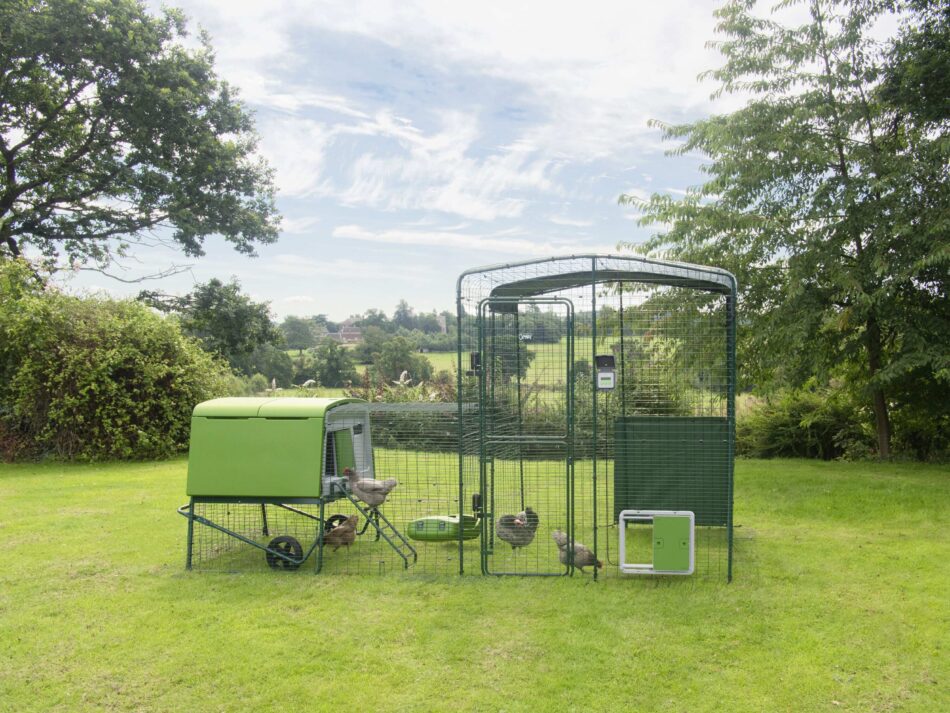

This entry was posted in Chickens
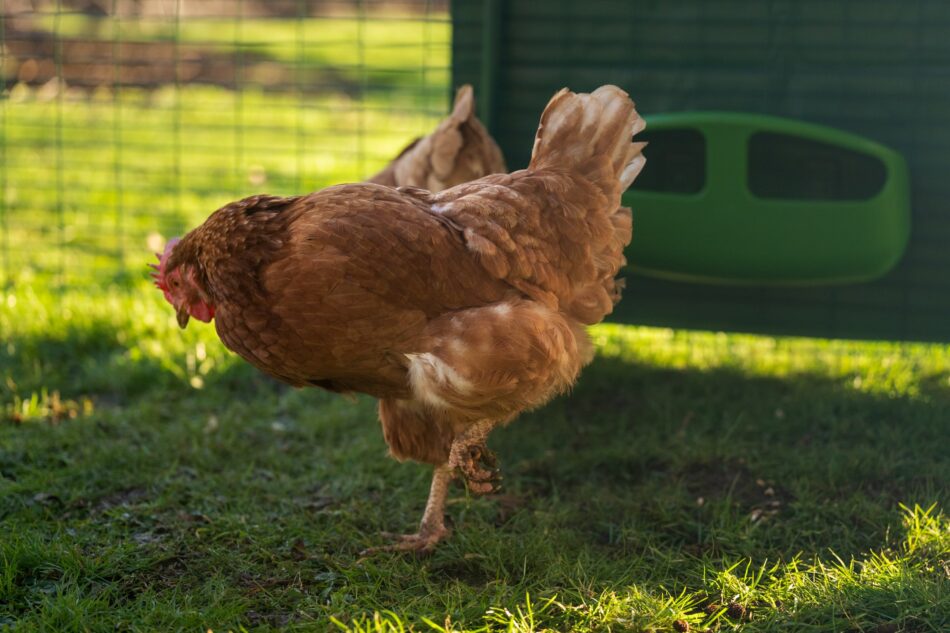
Keeping chickens is a great pastime for people of all ages and walks of life. Chicken keeping is rising in popularity, with more states and cities allowing small flocks in residential areas. With a few tips and tricks and a great setup, you can enjoy keeping your own flock of chickens in your own garden.
Are chickens the right pets for me?
Some of the things you’ll need to consider before keeping chickens are:
Chickens make wonderful pets that provide entertainment, companionship, and of course, eggs. The time needed to keep hens healthy and happy is flexible – and largely dependent on the breeds you’ve chosen and how you choose to keep your chickens. You can plan to spend anywhere from 1 to 4 hours per day tending to your flock.
Your flock will thrive on as much space you can feasibly provide them with. Hens naturally want to explore, forage, and scratch around in the earth, so the bigger the area, the more room for these activities.
Which chicken breed should I choose?
These breeds need more space than other breeds due to their desire to run and forage, or their size. Breeds that do well in confinement or smaller spaces include:
Where to buy hens & chicks
You can obtain your flock from chicken breeders or you may be able to adopt grown chickens from individuals and rescue groups such as the BHWT.
Chicks are fluffy and cute, and it may be tempting to start out with chicks instead of adult hens, but they require extra care and supplies that grown chickens do not. To raise chicks you’ll need:
- A special enclosure called a brooder pen
- Heat lamps or brooding plates
- Chick-specific feeders and waterers
- Feed formulated for chicks
Chicks need a heat source until they’re between 6 and 12 weeks old, depending on their breed. During this time they must be kept in their brooder pen and out of the elements, with short visits outside to slowly acclimate them to their environment.
Raising chicks can be rewarding, but if you don’t want to wait several months for your first eggs, or have to go through the process of keeping chicks in a brooder, starting with adult hens may be the best choice for you. Adult hens can go straight to your setup. And, with most breeds beginning to lay eggs by 16-20 weeks of age, older hens will be able to provide eggs for your family right away.
Choosing a coop
The best beginner chicken coop is one that will last a lifetime, with the ability to grow and be customised to accommodate your flock. Large chicken coops are best to start with, so that you have plenty of room to add to your flock, and to give your existing hens as much space as possible.
Omlet’s chicken coops have everything you need to get started keeping chickens. When choosing your chicken coop, you’ll want to weigh what is most important. Safety, comfort, and functionality should never be compromised in your chickens’ coop. When choosing between a wooden and plastic chicken coop, consider all of the upkeep involved with a wooden coop, and how difficult they are to clean. Our plastic chicken coops are easy to clean and keep your flock comfortable and protected all year round.
Choosing a chicken run
A chicken run will benefit your flock in many ways. From keeping them out of your prized flowers, to keeping them protected from predators, chicken runs help keep your hens healthy and happy. And, with the right chicken run, it will make keeping chickens even easier.
Walk in chicken runs are perfect for both keepers and flocks. They’re tall enough to give you access to walk with your flock, and offer enough space for them to exercise and explore their surroundings. All of our walk in runs feature anti-dig skirting to help prevent predators from tunneling in, and are fully enclosed with roof panels. And, with walk in chicken run extensions and chicken weather protection it’s easy to customise their experience and keep them sheltered from the elements.
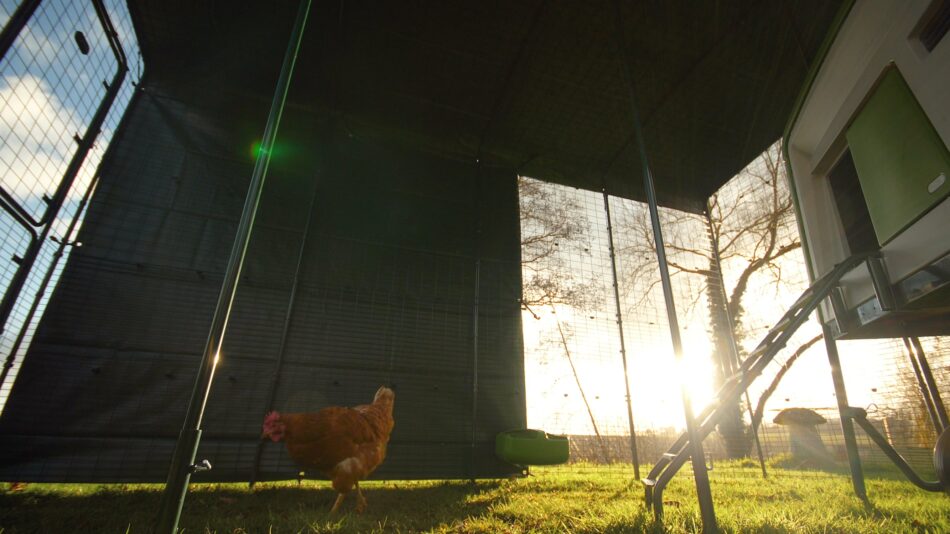
Keeping your chickens protected from predators
Chickens are animals of prey, so it’s up to their keepers to keep them safe from predators. Along with a strong chicken coop and predator-resistant chicken run, an automatic chicken coop door is an extra layer of protection against invaders. Chicken predators are most active at night, so by having a coop door that closes automatically either based on the sun or a certain time, you’ll make sure they’re tucked in tight when they’re at their most vulnerable.
Keeping your chickens fed & watered
Chicken feeders and drinkers are an essential part of keeping chickens. They should be elevated enough to deter hungry rodents, and have a covering to keep moisture out and to prevent your hens from tossing food around. Chickens should be offered quality layer pellets free-choice, along with occasional chicken treats.
Your flock should also have clean, fresh water available at all times. In the summer, toss ice cubes into their waterers to keep them cool. In the winter, break ice often to make sure your hens have access to thawed water.
Entertaining your flock
Like most pets, chickens enjoy toys. It’s a way for them to entertain themselves and engage both their bodies and brains. Our unique flock favourites include:
When you add these enrichment items to your hens’ space, you’re adding joy for everyone. There’s nothing quite like watching your chickens exhibit their natural behaviours through play.
Encouraging egg production
When provided with quality food and safe housing, hens will start laying sometime between 16-20 weeks of age. There are ways to encourage your hens to lay eggs during periods of stress, but healthy hens will lay all year round with the exception of moulting season (usually mid-late autumn). Your chickens’ eggs can remain in the coop for several days without compromising their nutritional value, but gathering them daily is the best practice.
Store fresh, unwashed eggs at room temperature for weeks, or even longer in the refrigerator. Egg skelters are unique and functional display pieces to showcase the fruits of your laying hens’ labour.
A typical chicken-keeping routine
Your daily routine with your flock will probably look something like this:
Morning
- Let chickens out of their coop
- Dump the droppings tray, wipe it down, and refresh bedding
- Top off feeders and waterers for the day
Afternoon
- Check for eggs
- Ensure water is fresh and at a palatable temperature
Evening
- Ensure your hens are in their coop for the night
- Remove any leftover food from the run to discourage rodents from visiting
You’ll quickly learn the best time to offer treats and socialise with your hens based on their personalities. Some hens are more active in the morning, while others may be more willing to socialise in the evenings. Hens will usually lay their eggs late morning through late afternoon, and it’s best to give them their privacy during this time. Plan coop cleanings around your flock’s laying schedule.
Common chicken health problems
Chickens are generally hardy pets that are resilient in many climates and conditions. Healthy chickens are bright and alert with good appetites and a predictable laying schedule. And, your hens’ eggs can be a good indicator of their overall health.
The best way to keep your hens healthy is to perform regular chicken health checks. If you find anything unusual or suspect your chicken is ill, report your findings to your veterinarian.
Rarely, garden flocks can contract avian flu, which is spread through the droppings and saliva of wild birds. Since there is no treatment for avian flu in chickens, covering your chickens’ run is the best way to prevent them from contracting the illness. You can find out more about avian flu in the UK in our Everything you need to know about avian flu blog.
What to avoid when chicken keeping
Keeping chickens should be relaxing and enjoyable for both the flock and their owners. To eliminate potential stress while tending to your hens, avoid:
- Starting out with roosters
- Buying a wooden chicken coop that will rot and need constant repairs
- Setups without enough space for your flock
- Coops and runs that cannot be added onto or customised later
Chicken keeping with Omlet
Omlet is here to support you through your chicken-keeping journey – right from the beginning. From our fun and quirky chicken clothing to our practical and beloved chicken perches, we’ve got everything you need to get the most out of your newly forged relationships with your backyard flock. So sit back, relax, and know that Omlet is here to make keeping chickens easier and better than ever.
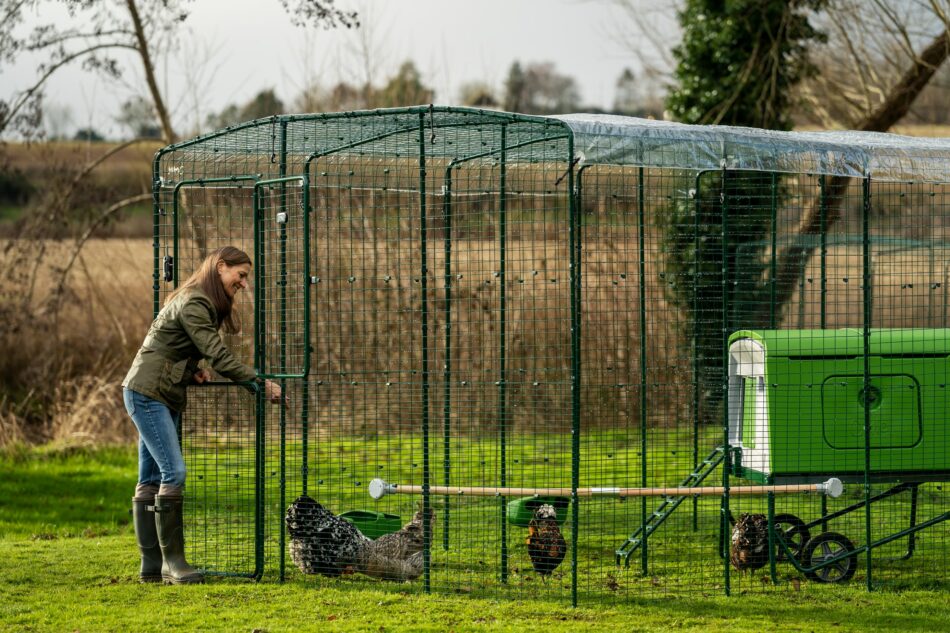

This entry was posted in Chickens

Summer is a great time to enjoy your chickens. But along with the summer fun comes sweltering heat and high humidity for many chicken keepers. Being aware of the signs of heatstroke in chickens can keep your flock safe and enable you to enjoy the warmer months along with them.
What is chicken heatstroke?
Heatstroke is what animals, including chickens, can experience when they become overheated to the point of it causing internal organ failure. Also known as heat exhaustion, heatstroke in chickens is more than just a hot hen — it’s the result of their body temperatures being elevated beyond a safe level for an extended period of time. Chickens that are too hot for too long simply can’t cool themselves anymore, and will succumb to heat exhaustion. When not treated properly and promptly, heatstroke can quickly become fatal to any affected hens. It’s important to help your chickens stay cool in the summer to avoid their body temperatures reaching this dangerous level.
Are any chicken breeds more susceptible to heatstroke?
Some breeds of chickens are more heat tolerant than others. The breeds that tend to not fare as well in hot climates are those that are bred primarily for meat such as Jersey Giants, and Delewares. Most egg-laying breeds of chickens do well in the hot weather as long as they have the right provisions — though some may need a little more support than others.
Silkies are a breed that doesn’t thrive in hot weather. This is largely due to their unusual feathers, as they can’t circulate air as proficiently as their regular-feathered cousins. Their head plumage can also obstruct their vision, making it more difficult for them to find water readily. Heavy breeds like Brahmas and Orpingtons may also struggle more in the heat due to their size.
Heat hardiness also depends on where chickens are raised. Hens that are adapted to the heat will fare much better than those that were relocated from a cooler climate to a warmer one. If you’re adding new chickens to your flock and experience intense heat in the summer, it’s best to obtain hens that are already accustomed to the warmer temperatures.
How to prevent chicken heatstroke
The old adage “an ounce of prevention is worth a pound of cure” is applicable when protecting your flock from heatstroke. One of the most important methods of keeping your hens cool in the heat is proper coop ventilation. Traditional wooden coops get stuffy and humid, keeping hens hot and uncomfortable. This can spell trouble quickly when the temperatures rise.
The Eglu Cube chicken coop by Omlet provides ample ventilation to move cooler air into the coop, which helps keep the internal temperature down. You’ll also want to provide as much shade as possible in your chickens’ run. This will help keep their body temperatures down, as well as keeping water sources cooler. Other preventative measures to combat heatstroke in chickens include:
- Providing plenty of fresh, cool water
- Letting your chickens dust bathe
- Offering frozen treats like corn or other chicken-safe vegetables
- Adding electrolytes to their water
- Frequently checking in on your flock to see how they are faring
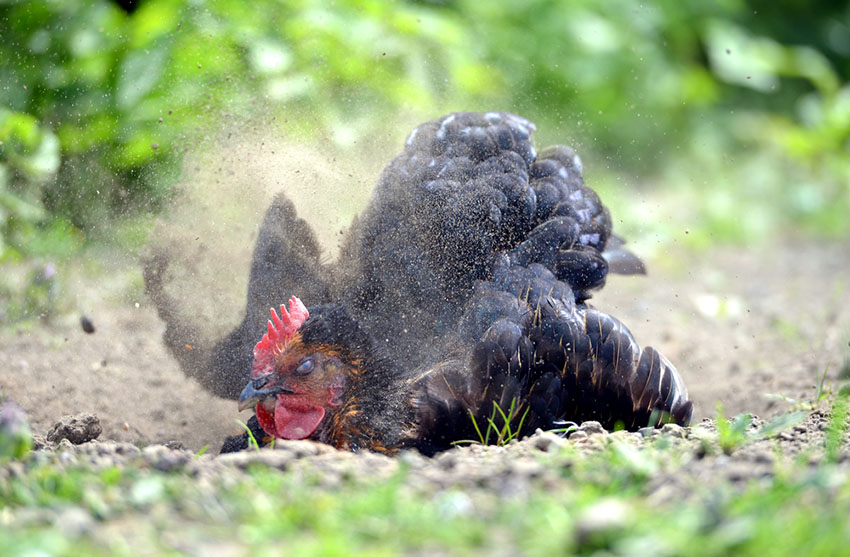
6 signs of heatstroke in chickens
Recognizing heatstroke in chickens quickly can make all the difference when treating it. Overheated chickens need prompt care in order to make a full recovery, so be on the lookout for the following signs of heatstroke in your flock.
1. Decrease in egg production
Chickens take their jobs of supplying eggs for your family seriously, so if they slow down or stop producing eggs then there is likely something amiss. Summertime is not part of the usual moulting season for chickens — which is the only natural reason for young (non-broody) hens to stop laying eggs. You should investigate the cause of any decrease in egg laying by your hens, especially in the summer months, as this can be a warning sign to your flock getting too hot.
2. Lethargy
Hens that aren’t willing to move, seem dull, or appear sluggish should be evaluated for heatstroke. When hens are merely resting they will be stirred easily by food or human contact. Lethargic hens may be slow to respond or refuse to get up for food or after a gentle nudge from their owner.
3. Panting
The open-mouthed breathing associated with dogs is actually a cooling mechanism employed by chickens as well. While chickens may not loll their tongues out of their mouths, they will pant with their beaks open. Panting for short periods of time is a natural response to the heat, but keep a close eye on your flock if you notice panting. Offer cool water or frozen treats when you first notice them displaying this behaviour.
4. Increased thirst
Are your flocks draining their drinkers? It’s good for chickens to drink more water during the summer, but make sure their waterers stay full and clean. Chickens can become dehydrated quickly on a hot day, and if their thirst can’t be slaked they will deteriorate rapidly. If you notice that you’re filling your flock’s drinkers much more often than usual, it could be a sign that they’re getting too hot.
5. Reduced feed intake
Healthy chickens also take eating very seriously. Any hens off of their feed need to be checked thoroughly. Make sure your chickens have access to quality laying pellets at all times, and offer frozen treats and fresh fruits and veggies often during the summer. Scratch grains are best offered in the evenings, as these grains increase your chickens’ metabolisms, which causes their bodies to heat up. The amount you feed your chickens should not need to be adjusted in the warmer months, and you can expect healthy hens to go through the same amount of feed as they normally would. Many animals (chickens included) will naturally eat less during the warm months, but it should not make a significant difference to your flock’s feeder.
6. Wings outstretched
Chickens don’t have sweat glands, so they have to find creative ways to expel heat from their bodies. Panting is one way, but stretching their wings or holding their feathers more erect is another. This allows more air circulation around their bodies and through their feathers in an effort to bring their core temperature down.
All of these symptoms can be signs of chicken heatstroke, but they can also point to other problems that can plague your hens. Familiarize yourself with chicken ailments so that you’ll be able to differentiate between conditions that may require different treatments.
How to treat chicken heatstroke
Preventing heatstroke in chickens is the best way to combat it. But, should you find any of your flock presenting with symptoms of heatstroke, you’ll need to act quickly. And, if the following actions don’t have your hen improving, it’s time to call your veterinarian.
First, you’ll need to move any affected hens to a cool, shaded area. It may be tempting to bring them indoors, but cooling them down too quickly can actually cause them to go into shock — which can be lethal.
If your hen is conscious and compliant, you can fill a bucket with enough cool (not ice-cold) water to submerge them from their neck down. It’s very important to not use very cold water, as cooling a hot hen down too quickly can cause them to go into shock, which is often fatal. After this brief soak, place the hen in a cool, shaded area until they are acting normally once again.
Omlet and keeping your hens safe
The Eglu Cube chicken coop by Omlet was designed to keep your hens cool in summer and warm in the winter. We want hens all over the world to be comfortable all year round. By putting chicken run covers over your flock’s outdoor space and providing them with the twin-insulated Eglu Cube, both you and your birds will be able to get back to enjoying a carefree summer.
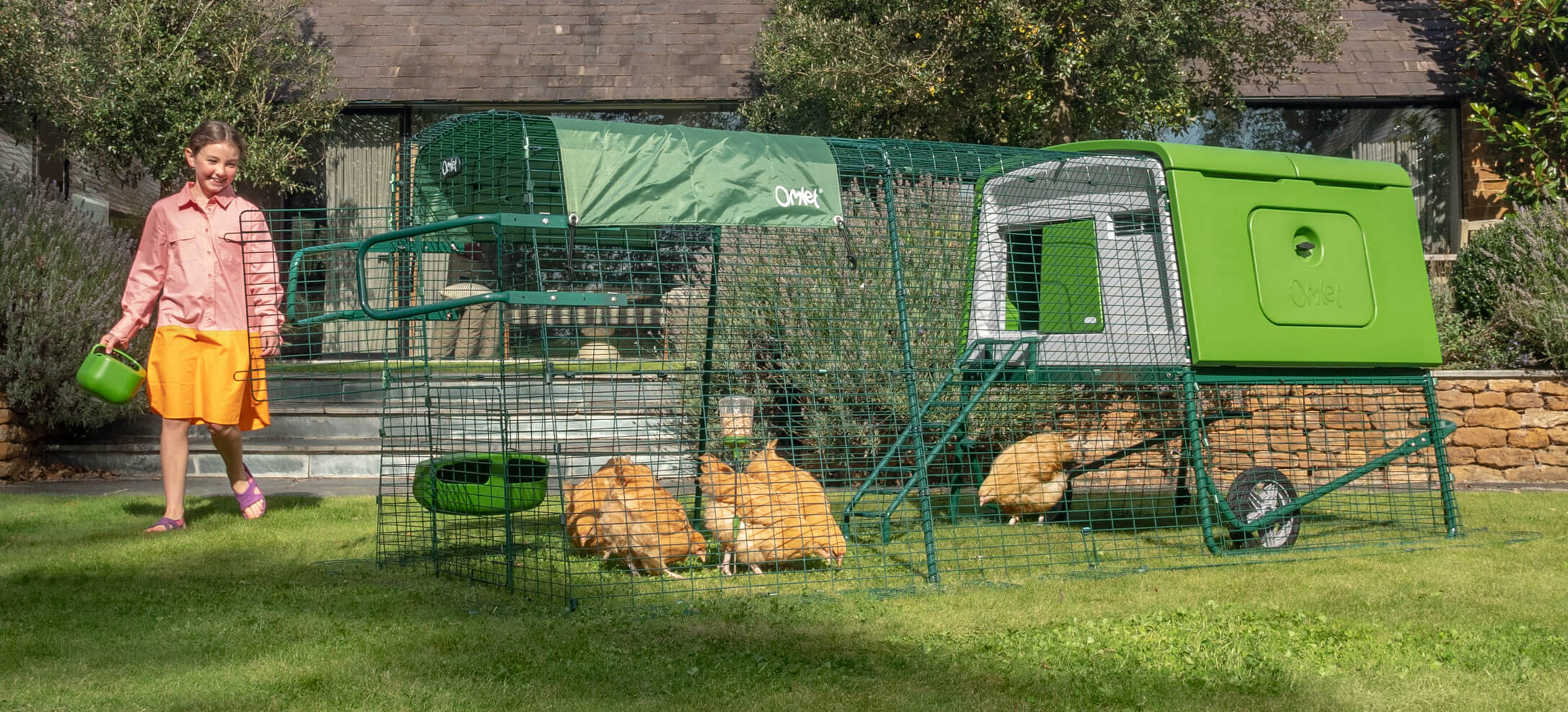

This entry was posted in Chickens
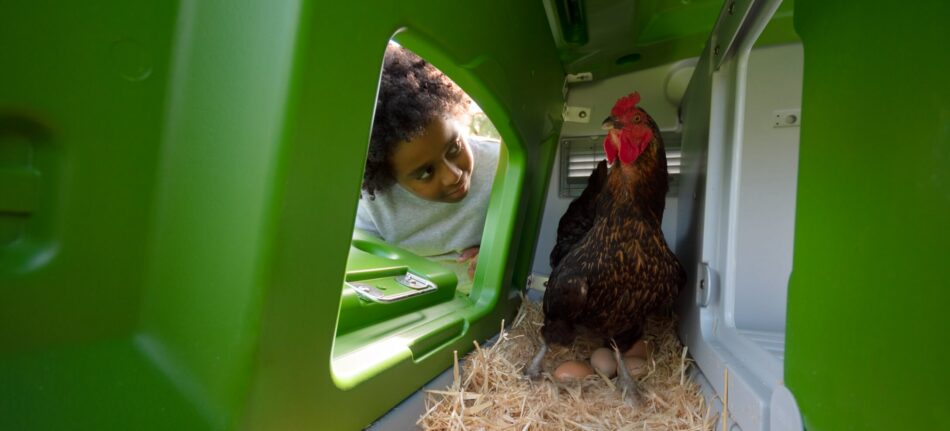
Chicken eggs are considered one of the healthiest food sources. Packed with essential nutrients and protein, it’s a staple in most family diets. But even more than a food source, chicken eggs are fun to gather, display, and hatch. Learn how to encourage your hens to lay beautiful eggs all year long, store these labours of love, and even hatch fertilised eggs with the help of an incubator or broody hen.
Creating the perfect environment for chicken egg laying
First and foremost, hens need a safe, quiet space to lay their eggs. Hens will naturally seek out the most suitable place to lay a chicken egg – so if a designated nesting area isn’t supplied to them, hens will venture off in search of the right spot. The ideal nesting area is in a covered space like a chicken coop, away from your flock’s active areas. Enclosed nesting boxes or spaces are preferred, as hens will instinctively want their eggs safe from chicken predators.
Omlet’s hen houses have designated nesting areas inside that are comfortable and secluded. Hens will feel safe inside of their enclosed coop’s nesting area, and with the rest of the flock out for the day, will have the privacy needed to encourage egg laying.
How to encourage egg laying
Good laying hens can produce over 250 eggs per year without much supplemental encouragement. As long as they have adequate space and nutrition, their natural egg-laying cycles should remain intact. Aim to give your flock as much space as possible outside of the coop, whether free-ranging with the help of chicken fencing or in a chicken run.
Laying hens should have a diet consisting of:
- Quality scratch grains and chicken treats offered daily
- Access to fresh, clean water in a chicken waterer
- Free-choice of high-quality layer pellets or crumbles, with protein levels between 16%-18% depending on their breed
- Fresh greens or grass as often as possible
What to do if your hens stop laying eggs
If you notice fewer eggs in the nesting area, it’s time to perform a health check on your chickens. Any hens with noticeable discomfort should be quarantined, and you should contact your veterinarian. If all of your hens appear healthy, there are 6 other ways to boost egg production among your flock:
- Offer chicken supplements
- Increase the protein of your hens’ diet
- Switch to a different feed
- Make sure your hens are visiting the nesting box, as they could be laying eggs elsewhere
- If you have a broody hen among your flock, it may affect your other hens’ cycles
- Make sure your hens are not moulting, as egg production will decrease for several weeks during a moult
If these methods don’t help or give you insight into any potential issues, contact your veterinarian.
How and when to collect your hens’ eggs
It’s important to collect your chickens eggs daily. Eggs left in nesting areas are at risk of being cracked or broken by multiple hens using the nest. And, eggs left in the coop may draw in pests or predators.
How often hens lay eggs
Good laying hens will produce an egg approximately every day and a half. The majority of hens will lay their eggs in the late morning or early afternoon hours, but there may be some stragglers toward the end of the day. It’s very uncommon for hens to lay their eggs overnight. This means that early evening would be the best time to check your coop for chicken eggs.
If you’re concerned about how long your hens’ eggs can stay in the coop, try to collect them at least once a day. But, in general, eggs are still safe to consume even if they are left to sit in the coop for several days. The hot summer months will reduce this timeframe, but eggs are still safe to consume after exposure to the heat. Winter months pose a challenge due to the risk of eggs freezing in the coop. If your area experiences prolonged temperatures below freezing, you may want to check your coop several times a day before eggs have a chance to freeze solid.
Daily egg collections
Daily egg collections will also help deter hens from going broody. If you want to keep hens from becoming broody, remove any eggs from under a hen that has been sitting for longer than usual to lay an egg. Be cautious – even the most docile hens can get aggressive when protecting a clutch of eggs they’ve decided to sit on.
How to tell if a chicken egg is fertilised
Eggs require a cockerel in order to be fertilised. Cockerels fertilise the eggs before they are laid, so if you have a cockerel in your flock, there’s a potential for any of your hens’ eggs to be fertilised.
There are some misconceptions about cockerels, eggs, and fertilisation. The most common ones are:
- Hens do NOT need a cockerel to produce eggs – they will lay eggs regardless
- Not all chicken eggs will be fertilised if you have a cockerel in your flock
- The only way to know if a freshly laid egg is fertilised is to crack it open
If you’re interested in hatching your own chicken eggs, the best method is to pay attention to the eggs you’re eating. When you crack them open, look for a “bullseye” pattern in the yolk. This subtle change that appears as a target will be your clue that the egg is fertilised. If you notice most of the eggs you’re cracking are fertilised, start saving a few to place in an incubator. After 1 week in the incubator, you’ll be able to candle the eggs to see if there is embryonic development.
How to hatch eggs
Hatching your own eggs is an exciting experience. If you choose to incubate your eggs instead of having a broody hen sit on them, you’ll be able to document their progress by using an egg candler. This special light will help you see how the chicks are developing, and will help you dispose of any unfertilised eggs before they spoil and burst.
To hatch your own chicken eggs, you’ll need:
- An incubator
- Thermometer (if not included in your incubator)
- Hygrometer to monitor humidity level
- Egg candler (optional)
Chicken eggs take 21 days to hatch from the time of incubation. It’s best to place eggs in the incubator as soon as possible, but if you must store eggs before incubation, they can be kept in temperatures between 13-18°C for up to 7 days.
On day 18 of incubation, you’ll want to “lockdown” your incubator. This means you’ll add water if needed (humidity levels need to increase to 65-70% in the final 3 days before hatching). Turn off any automatic turners, or stop hand-turning your eggs on day 18, and place a non-slip covering on the hatching floor of your incubator so that newly hatched chicks do not develop splayed legs. A paper towel or non-slip shelf liner that will allow ventilation are both good options.
Taking care of chicks once they’ve hatched
Once your chicks have hatched, be sure to leave them in the incubator until they are dry and fluffy. This will ensure they don’t get chilled when they’re moved to their brooder pen. The nutrients that fed chicks while they were inside of their eggs will sustain them for up to 48 hours after hatching, so it’s safe to allow them to fully dry before moving them.
When raising newly hatched chicks, make sure you have:
- A secure brooder pen with a top to prevent escapes
- A heat source like a brooder plate or lamp
- Chick starter crumbles – medicated or non-medicated depending on your preference
- Chick-specific feeders and waterers
- Absorbent bedding like pine shavings or pellets
- Adequate time to check in on your chicks daily
Chicks can be quite messy as they work on their coordination. Waterers should be checked frequently for debris to make sure they have access to clean water, and feed should be refreshed. Growing up is tough work, and chicks will need to consume a lot of feed.
The benefits of having your own egg-laying chickens
There are many benefits to keeping your own chickens, like:
- Supplying your family with fresh eggs
- Providing exceptionally nutritious chicken eggs
- Having your hens help with pest control and lawn care
- The opportunity to experience owning a unique pet
There’s nothing like gathering freshly laid eggs from your own flock of chickens. Proudly display your hens’ labours of love in an egg skelter on your kitchen counter, or gift friends and family members with small packs of eggs.
Best breeds for egg laying
There are many different breeds of chickens, many of which are known for their proficiency in laying eggs. Some of the best breeds for egg laying include:
Chickens that are bred for ornamental purposes will still lay eggs, but at a much lower volume than laying breeds. Bantam (miniature varieties of full-sized breeds) also lay eggs, but they are much smaller and less frequent than their full-sized counterparts.
Cleaning your eggs with care
Storing fresh chicken eggs depends on how quickly they’ll be used, and as a matter of personal preference. There are two main ways to keep eggs fresh:
- Leaving them unwashed and set out at room temperature
- Washing them and storing them in the refrigerator
It’s very important that any eggs left out at room temperature remain unwashed. Introducing eggs to water or cleaning solution removes the bloom (microscopic protective barrier) from the shell. Egg shells are semipermeable – meaning air and moisture can pass in and out. Once the bloom has been washed off, the eggshell loses its natural barrier to keep harmful bacteria out.
Unwashed eggs can also be stored in the refrigerator, but washed eggs must be stored in the refrigerator to remain fresh. That’s why store-bought eggs are refrigerated – they have all been washed.
If you choose to wash your eggs, you can either make a DIY egg cleaning solution from vinegar or purchase ready-made egg cleaning products. Or, if you want to simply use water, soak your eggs in warm water, as this will help keep bacteria from entering through the pores of the shell. After a nice soak, gently rub your eggs with a cloth or soft-bristled brush. Dry with a towel, and promptly place your cleaned eggs in the fridge.
Chicken egg colour guide
Did you know your hens’ eggshell colours are the result of genetics? Hens will lay the same coloured eggs their entire lives. Some breeds are bred to lay specific colours, while other breeds differ from hen to hen. Sometimes nutrition or health changes can subtly impact the colour or appearance of your hens’ eggs, but you should expect consistency from your hens.
Common chicken eggshell colours include white or cream, and browns in various hues. Chicken eggs can also be blue, green, and even pink. Most eggs are a solid colour, but some breeds like Marans, Barnevelders, and Welsummers can lay speckled eggs.
Your hens’ eggs tell about their health. Sometimes misshapen, discoloured, or eggs laid with shell anomalies point to a nutritional deficit. If you notice your hens laying eggs that aren’t consistent with their previous appearances, it’s best to evaluate their diet.
Frequently asked questions about chicken eggs
How frequently do chickens lay eggs?
Every hen is different, but peak age for most laying hens is around a year and a half through 2 or 3 years of age. During that time, a good laying hen should produce anywhere from 250-350 eggs per year depending on their genetics. Egg production will decrease as hens age, and will also dip or stop altogether during their yearly molting cycle. Some hens may also decrease egg production in the wintertime to reallocate energy to stay warm.
Do chickens stop laying at a certain age?
Depending on their breed, most chickens will stop laying eggs by the time they are 4 or 5 years old. There are some breeds of chickens that will lay well into their later years, while others will drastically decrease production by year 3 or 4.
How do chickens lay eggs?
Chickens ovulate in order to lay an egg. Ovulation takes about 24 hours to complete, and starts in the ovary. The yolk is formed first, then passes through the oviduct where it is surrounded by the white (also called the albumen). Finally, the egg is encased in its shell inside of the hen’s uterus (or “shell gland”). Shell formation takes roughly 20 hours, after which the egg is laid by the hen via the cloaca or “vent”. All excretions from the hen exit through the vent, but during egg laying a hens’ uterine lining stays with the egg until it has been deposited – keeping it nice and clean.
Do chickens eat their own eggs?
Hens may begin to eat their own eggs for the following reasons:
- Nutritional deficiencies – usually low calcium intake
- Dehydration
- Boredom
- Stress
- Feeling unsafe in the nesting area
Keep your hens from eating their eggs by supplementing their diet with calcium. Crushed oyster shells can be purchased from feed stores, or you can save the eggshells from eggs you are using to crush and feed back to your hens for a boost in calcium. Always make sure your hens have plenty of fresh water to ward off dehydration.
Provide boredom-busting activities with chicken toys, and make sure your hens are housed in secure chicken coops and chicken runs. Hens that don’t feel safe may eat their eggs to hide evidence of their presence from chicken predators. Consider installing an automatic chicken coop door to make your hens’ feel more secure in their home.
Get more chicken eggs with Omlet
All of our chicken products are designed to promote safety, comfort, and security for hens, and for ease of use for their caretakers. Healthy, happy hens lay more eggs – so give them plenty to occupy their busy minds. A walk in chicken run gives your flock ample room outside of the coop to forage and play. Add a Chicken Swing to give your hens a unique place to relax in between egg-laying sessions, and to provide versatility in their space.
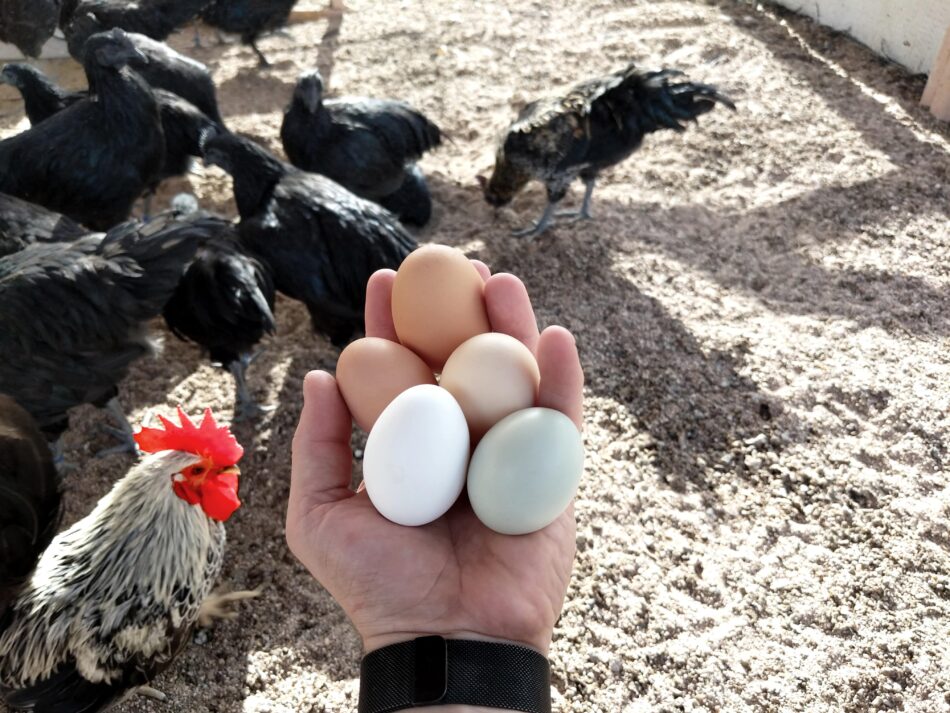
This entry was posted in Chickens
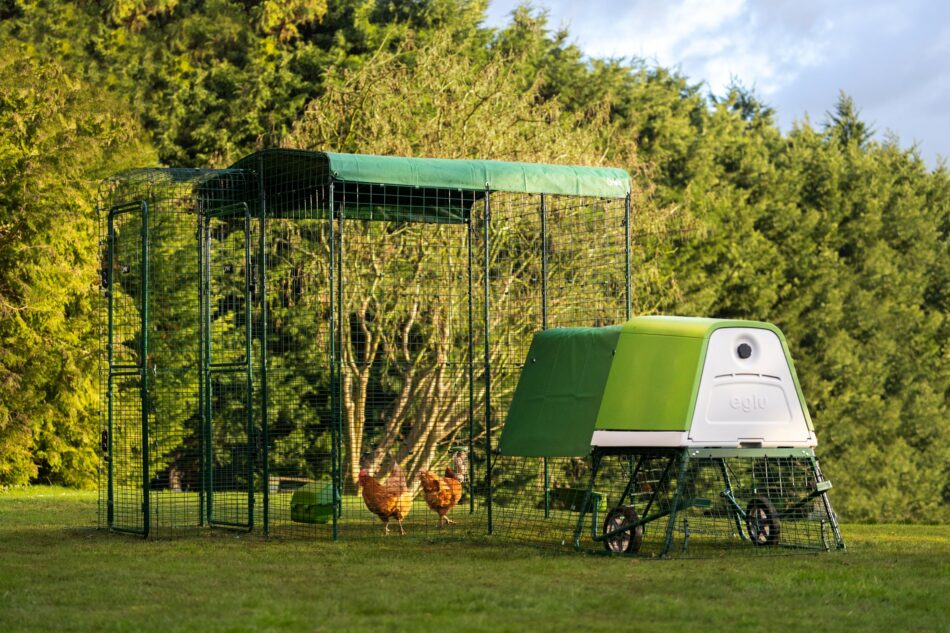
Looking for a beginner chicken coop? The best chicken coop for beginners are those that can grow along with flocks and their keepers – making it the first and last chicken coop you’ll need to buy. There’s a lot hinging on your hens’ home: their health, safety, and comfort. You’ll also want a coop that is easy and quick for you to clean, and is enjoyable to use. Omlet has the coops to check all of those boxes – and more.
The best Omlet chicken coops for beginners
The best chicken coops grow with their flocks and keepers’ level of experience. And, the best beginner chicken coops are easy to use from the start, but also functional and practical enough for even the most advanced chicken keeper.
We’ve made keeping chickens easy for all ages and stages of flock-raisers. Omlet’s line of Eglu chicken coops not only provide superior safety and comfort to the hens they house, but also allow owners to spend less time cleaning and worrying and more time enjoying their flock.
All of our coops are:
- Easy to build
- Simple to clean
- Predator resistant
- Have the ability to be mobile with the addition of our wheels and handles kit
- Are twin-wall insulated, keeping your flock comfortable all year round
Choosing your chicken coop depends on your space and how big of a flock you intend to keep. Once you’ve got an idea of where you want to place your coop and how many hens you want to have, you’re ready to find the coop that best fits your needs.
Types of chicken coops
There are a few choices to make when it comes to buying a beginner chicken coop. Some popular options are:
Each type of chicken coop has their own advantages, so you’ll need to decide which option best fits your lifestyle and space. For example, mobile chicken coops allow you to move your flock around your garden whenever you’d like. This lets your hens peck new grass and prevents a permanent spot from being worn into your lawn. Large chicken coops can house up to 10 small breed hens comfortably, and can also be converted into chicken tractors. Ground-level coops are best for chickens that don’t have a strong roosting drive, or for gardens subject to height restrictions.
Wood vs plastic chicken coops
Above all, the best chicken coop for beginners is a plastic chicken coop. There are many reasons why plastic chicken coops are better than wooden chicken coops, as plastic is:
- Easier to clean
- Mite-resistant
- Rot-proof
- Better insulated
- Draft-free
- Easier to assemble
Purchase a plastic chicken coop at the beginning of your chicken-keeping journey, and it will serve you and your flock for years to come.
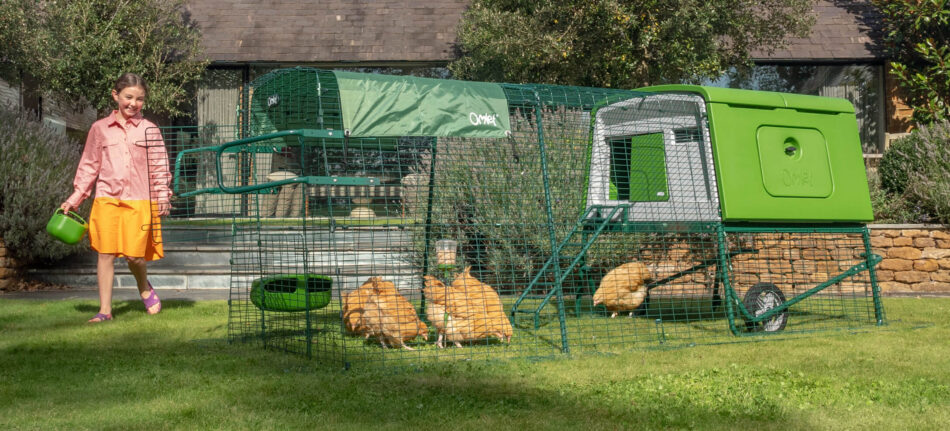
DIY vs ready-made chicken coops
Deciding whether to buy or build your first chicken coop? Building a proper chicken coop from scratch is hard – especially if you’re new to chickens. Hens have essentials when it comes to their home, and it’s hard for DIY plans to get them right. Most DIY plans look aesthetically pleasing, but leave much to be desired in functionality, safety, and practicality.
Omlet coops come as a kit to be assembled and have everything you need to get started with your flock right away. Our designs have been keeping hens healthy and happy for over a decade – so there’s no guesswork for you.
Choosing the perfect size coop for your flock
There’s a term that all chicken keepers will experience at some point: chicken math.
It’s used to describe the phenomenon of bringing home more chickens than you originally intended. This can occur right off the bat, or take a few months to set in, but at some point, most (if not all) chicken keepers crave more chickens.
That being said, it’s always best to get the biggest coop you can for your space and budget. Chickens thrive when as much space as possible is available to them, and extra space allows room for the inevitable chicken math conundrum.
What needs to be in your new chicken coop
A good chicken coop keeps hens comfortable, safe, and shielded from the elements – but a great chicken coop offers entertainment and enrichment as well. Chickens get bored if they don’t have enough stimulation, which can lead to behavioural and health issues. Be sure to offer a variety of things to keep your flock busy when they’re in their coop’s attached run. To bust boredom, try offering:
The more space and activities your hens have, the happier and healthier they’ll be. Some other ideas to keep boredom at bay include: serving fresh veggies in a Caddi Chicken Treat Holder, socialising with your flock, or moving a mobile chicken coop to fresh pecking grounds.
Top chicken coop care tips for new keepers
New chicken keepers should keep the following in mind when taking care of their chicken coops:
- Clean out your chickens’ coop daily to keep it fresh and to keep your hens’ in good health
- Use an odour-absorbing bedding such as pine pellets or shavings
- At least once a week, remove the roosting rack and droppings tray from your coop to pressure wash, or scrub with soap and water
- Collect eggs daily to help prevent broody hens and visits from predators
Keeping your chicken coop clean is one of the best ways to ensure that your hens are in a healthy atmosphere. Like most birds, chickens keep themselves clean through preening and dust bathing – but it’s up to their owners to keep up with their housekeeping.
Choosing a run your flock will love
Companion pieces to most chicken coops are chicken runs. Even if you want your hens to have access to most of your garden, there will inevitably be times that you’ll want to keep them penned up in a run. Large chicken runs give flocks that free-range feeling, without the hazards.
The best option for large spaces is a walk in chicken run. Not only does it maximize your chickens’ space, but it allows you to walk with your flock and get closer than ever to your hens. Omlet’s walk in chicken runs can also be extended at any time to accommodate a growing flock. Covers for walk in chicken runs can be added to give your flock shade from the sun or a barrier from snow, rain, and wind.
Other considerations when choosing your coop
Once you’ve researched and chosen the type of coop that best fits your lifestyle, you’ll also need to consider: chicken predators, the changing seasons, and zoning laws that may be applicable to you.
Predators
Omlet coops are designed to protect against chicken predators. The types of predators vary depending on your location, and you can bet that at some point they will come after your hens. Common chicken predators include:
- Foxes
- Badgers
- Neighbourhood cats and dogs
Adding an automatic chicken coop door to your chickens’ coop adds an extra layer of protection against predators. The Autodoor ensures that your flock is safely closed into their coop each night, and the horizontal opening mechanism makes it extremely difficult for predators to pry open.
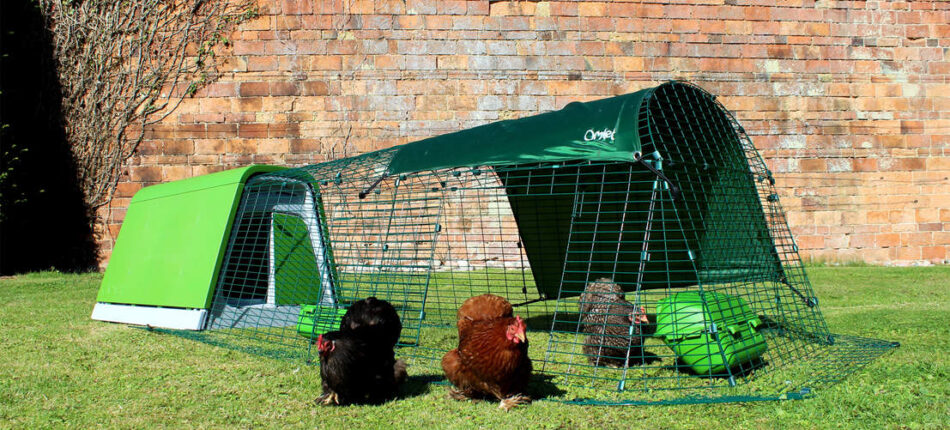
Seasons
Chickens are amazingly resilient, being built for life outdoors. However, not all breeds fare well in extreme temperatures. That’s why it’s so important to choose breeds that are suited to your location’s climate. Cold hardy breeds typically don’t fare well in the heat, while heat-tolerant breeds may struggle in the bitter cold. Ageing hens may also not weather the changing seasons as they once did, and some minor coop modifications can go a long way in helping them through more extreme temperatures.
For the winter, an extreme temperature jacket can be added to your chickens’ coop as an extra layer of insulation. Weather protection for attached chicken runs in the form of tarps and covers can also be added to keep snow, rain, and wind off of your hens.
The same tarps and covers can also be used for hot weather conditions by providing shade on scorching days. Hens often do well in warm weather as long as they have adequate shade and water.
Keeping chickens for the first time
Getting chickens for the first time is an exciting experience. But don’t forget that preparation goes a long way when getting ready to bring your flock home. Make sure you have the time, space, and supplies for your hens before committing to being a flock’s forever home. Some additional things to consider when keeping chickens:
- A safe, comfortable chicken coop
- Chicken run
- Perches
- Food
- Feeders and waterers
Make sure all of your equipment is assembled, and familiarise yourself with it before introducing your flock. You may find yourself wanting to make minor adjustments such as moving feeders and waterers or perches around, but the majority of your chickens’ set-up should be well established by the time your hens come home.
Your first and last chicken coop with Omlet
Choosing your chicken coop is a commitment, but when the creators of the coop are as committed to chickens and their keepers as Omlet, you’re sure to have the best experience possible. And, don’t forget to have fun with your flock. Accessories for your chickens take flock-keeping to the next level, and chicken treats help you quickly bond with your hens.
When you choose Omlet for your chickens’ coop and accessories, you’re not just purchasing your first coop – it’s the only coop you’ll ever have to buy. Unless of course you fall victim to chicken math and need more chicken coops. Don’t say we didn’t warn you!
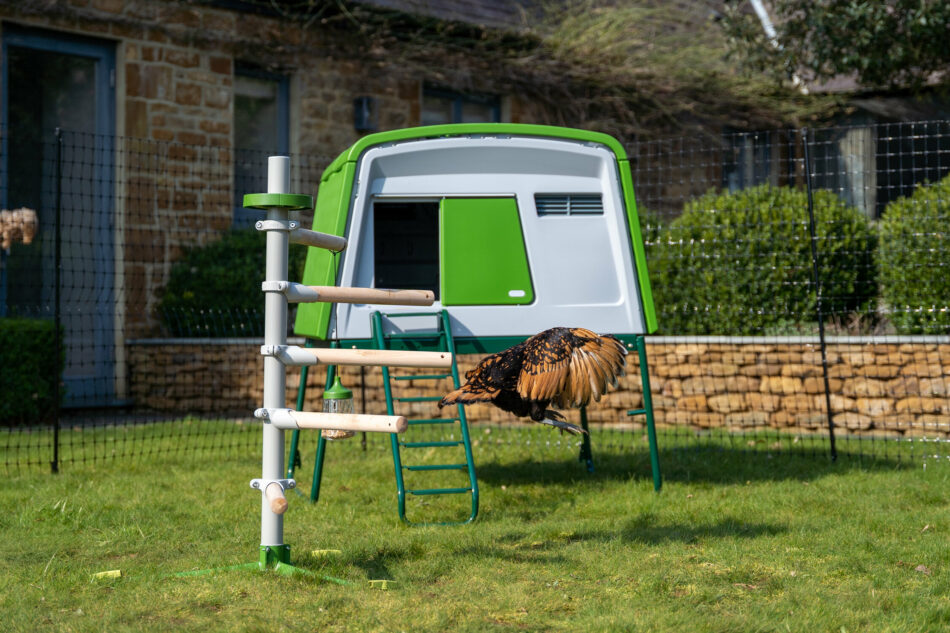

This entry was posted in Chickens

You may not find a class on raising chickens for beginners at your local college – which is why we’re here to help you get started on your chicken-raising journey. Lots of information about chicken care for beginners can be found online, but it can all be a bit overwhelming. The surest way to succeed is to stick to the basics, purchase high-quality chicken products, and to keep things simple. Omlet has the knowledge and the products to help you succeed when getting chickens for the first time.
Reasons to start raising chickens
If you’re new to poultry, getting chickens for the first time can seem daunting. Hens are often viewed as farm-specific animals whose main purpose is to lay eggs. But chickens actually make wonderful pets that are full of personality and character.
There are so many benefits of raising chickens. These include, but are not limited to:
Flocks can be raised in urban or rural settings, and don’t require much space. Don’t let where you live keep you from entertaining the thought of keeping hens of your own.
Preparing for your new chickens
Getting chickens for the first time is an exciting and joyous occasion so long as proper preparations are made. There are a few things to consider before bringing home new chickens like:
- How much time you have to devote to their care
- Space requirements for your desired flock size
- Other family pets that may pose a risk to your hens
- Selecting your chicken coop and run
Chickens don’t require as much hands-on care as other pets do, but will still need to be looked after daily. Make sure you have adequate space for the number of chickens you want to keep – giving them as much space as possible. Secure your chickens’ area to prevent other pets or predators from reaching them.
The best beginner chicken breeds
It’s a good idea to research and decide which breeds of chickens you want to keep before bringing any hens home. Different breeds have different qualities and temperaments, but here are some that are known for being great hens for first-time chicken keepers:
Consider your climate, available space, and egg-laying expectations when selecting which breeds you want to keep. Keeping a “mixed flock” is common among chicken keepers, as it adds variety to your egg basket.
If you’re getting full-grown chickens, select your hens based on temperament and appearance. As with other pets, hens have unique personalities and some may be more in sync with your own personality.
Getting started with chicks vs mature hens
If you want to start your flock from chicks, it’s best to familiarize yourself with the breeds you want to keep. Once you’ve decided on which breeds you want, you’ll need to know where to find and buy your chicks. Common options include local feed stores, breeders, or even online hatcheries. No matter where you purchase your chicks from, be sure they are reputable establishments or breeders for the types of chicks you’ve chosen.
There are a lot of factors to consider when deciding whether to raise your flock from newly-hatched chicks, or to start out with established hens. Chicks require more time and resources for the first several weeks of their lives. But, raising your chickens from the start can offer several benefits as well.
Raising chicks for beginners
Raising chicks can be a very rewarding experience for any flock-keeper – beginner or experienced. Chicks grow fairly quickly, but do require extra care and equipment until they’re old enough to be more self-sufficient. To raise chicks, you’ll need:
- A secure brooder pen
- A heat lamp or brooder plate
- Chick-specific feeders and waterers
- Chick-feed and grit
With each new stage of raising chicks comes different necessities. Newly hatched chicks will need a special enclosure called a “brooder” for the first several weeks of life. A brooder should be predator-resistant and kept somewhere out of the elements. Garages, barns, or shops are ideal places to keep brooder pens. Chicks will also need a heat source (which mother hens would ordinarily provide) that is adjusted weekly to help them adjust to life outside. You can expect to house and care for your chicks in their brooder until they are around 12 weeks old.
One of the greatest benefits of raising chicks is being able to handle them from a young age. Handling your chicks daily will help to make them more docile as adult hens. After a few weeks of being handled and housed in the brooder, your chicks will be ready to be moved to their permanent home.
Choosing the perfect beginner’s coop
Aside from the chickens themselves, a chicken coop is the most important aspect of keeping chickens. And, as a beginner, you’ll want a coop that works with you, not against you. For example, DIY chicken coop plans may look appealing, but they often lack fundamental provisions for your flock. It’s important to have a safe, easy-to-clean, comfortable coop for your hens.
The process of choosing your chicken coop can be simplified by following these suggestions:
- Decide if you want your coop in a permanent location, or want the freedom of a mobile chicken coop (also known as a chicken tractor).
- Think of your garden’s space, and how large of a flock you intend to keep. If you want to keep more than 4 hens, you’ll need a large chicken coop.
- Determine how much time you want to dedicate to cleaning and maintaining your chicken coop and run. It’s important to remember that wooden chicken coops all require routine maintenance, updating, and take several hours to clean thoroughly.
Plastic chicken coops don’t rot, peel, or succumb to the elements – so they require zero maintenance. Omlet chicken coops are also incredibly easy to clean: simply remove the droppings tray and roosting rack, dump the bedding, spray or wipe clean, add fresh bedding, and place the components back in the coop. Our coops take all of the guesswork out of chicken care for beginners, and allow you to spend more time enjoying your flock, and less time cleaning and maintaining their coop.
Create space to roam with a chicken run
Chickens crave space – and lots of it. Chickens are much happier when allowed as much space as possible to explore. Chicken runs give your flock a safe space outside of their coop to peck at grass and insects, stretch their legs and wings, and soak in fresh air and sunshine.
A great option for first-time chicken owners is a walk in chicken run. These runs not only give your hens more aerial space for chicken perches, but also allow you to easily walk with your flock. Our chicken coop attached runs can be easily integrated with a walk in run, or you can simply place your chickens’ coop right inside of the walk in run.
We’ve also made it possible to extend your walk in run as your flock grows. Both the length and width can be extended at any time, giving your hens maximum space. You can also add walk in chicken run partitions to create different areas of your walk in run. This is helpful for keeping hens separated if needed or when introducing new flock members.
If free-ranging is more in line with your lifestyle, consider chicken fencing to keep your hens close to home. Chicken fencing can be used to prevent your flock from getting into flower beds, wandering off of your property, or straying too far from home. Configure a pen of any shape with posts that can be repositioned at any time, or anchor the fence to a structure with a wall mount. An easy-access gate allows you to spend time with your hens while they explore their surroundings.
What hens eat & drink
As caretaker of your chickens, you’ll need to decide what they eat and when. Chickens are fairly self-sufficient, and prefer their feed to be left out free choice. To keep your flock fed, keep their chicken feeders full of quality feed.
If your hens are laying age (16 weeks or older), they’ll need to be fed laying pellets or crumbles. Both varieties of feed offer the same nutrients, and choosing between pellets or crumbles is a personal preference. Some hens (especially small breeds) or older chicks transitioning from chick crumbles to laying hen feed may do better with crumbles.
Chicken treats can be offered when bonding with your flock, but should not make up a sizable portion of their diet. Make sure your chickens have access to fresh, clean water at all times. Place your flock’s drinker high enough that bedding or dirt doesn’t get kicked in while your hens are scratching the ground, but low enough for your smallest hen to access.
Caring for your flock
Getting into a routine will come naturally after you’ve tended to your chickens for a few weeks. Coop cleaning, feeding, watering, and egg collecting are all part of the daily task list for chicken keepers. If you’re unsure about what your routine should look like, here is an example of a daily routine keeping chickens with an Omlet setup:
Morning
- Let chickens out of their coop and into their run or fencing
- Clean the coop and refresh bedding
- Feed chickens and top off waterers
Afternoon
- Collect eggs
- Check feeders and waterers (if the weather is warm, refresh with cool water)
Evening
- Close chickens in their coop once they’ve gone to roost
- Pick up and store any uneaten food for the next day (this reduces the number of visits from rodents)
Chickens thrive on routine, and will help you establish one that works for both of you. Most chickens are ready to go out of the coop at sunrise, and will naturally go in to roost around sunset. Hens will usually lay eggs in the late morning or early afternoon, but the timing will vary between chickens and seasons. It’s not common for hens to lay eggs overnight, but it’s good practice to check the nesting box each time you visit the coop.
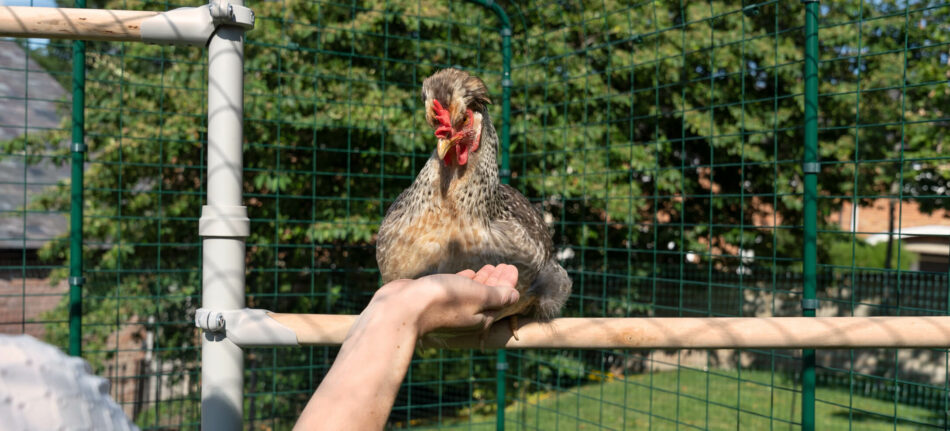
Predators, & protection from seasons
You’ll need to make a few adjustments to your flock’s setup depending on where you live. Luckily, Omlet makes it easy to adapt and overcome obstacles as a new chicken keeper.
Chicken predators
Chicken predators are an unavoidable part of keeping a flock. No matter where you live you’ll encounter predators that will try to take advantage of hens that aren’t fully protected. From foxes to neighbourhood dogs and cats you’ll need to fortify your flock’s home.
Make sure your chicken coop doors are secure and have mechanisms that can’t be pried open by pesky paws. Installing an automatic chicken coop door adds an extra layer of protection between your hens and predators trying to get in a closed-up coop. The horizontal open and closing mechanism helps prevent the door being pried open – unlike vertical opening doors.
Seasonal protection
As outdoor pets, your chickens need different care during different times of the year. Most chicken keepers elect to cover their chickens’ runs to protect them from the elements. Omlet’s line of heavy-duty chicken run covers offers protection from rain, snow, wind, and harmful UV rays. Our solid covers are perfect for providing shade on a hot summer day, while our clear covers allow sunlight to filter through to warm your hens during the chilly winter months.
The temperate weather of spring and autumn is favourable for hens, depending on your location. And while most breeds of chickens tolerate both high and low temperatures, if your area experiences extreme temperatures you’ll need to take additional measures to keep your hens comfortable.
To keep your hens cool in the summer, make sure they have plenty of water and shade. Omlet’s chicken coops keep hens cool through thoughtful design, and will help your flock weather the warm summer nights.
During extreme cold temperatures in the winter, consider adding an extreme temperature jacket to your chickens’ coop. While our Eglu chicken coops are designed to keep the inside temperature at a comfortable level, your hens will appreciate the extra layer of insulation during the bitterly cold months. Be sure to also offer your hens plenty of perching space as reprieve from the frozen ground. Offer warming chicken treats to keep their metabolisms up and to promote egg laying.
Encouraging egg production as a beginner
Egg-laying breeds of chickens will produce approximately 1 egg every day and a half. That means that during peak laying age (around 2 years old), high-producing egg layers can give between 300-350 eggs per year. But do they need your help to accomplish this?
Many first-time chicken owners wonder what they can do to encourage hens to lay eggs. The main components to help keep hens happily laying are:
- Quality feed
- Fresh water
- Adequate space
- A clean environment
- Feeling safe
If these needs are being met, your hens should lay on a regular schedule, routinely providing fresh eggs for your family. Once collected, fresh eggs can be stored at room temperature or in the fridge for several weeks. You may want to display your hens’ hard work in your kitchen by using an egg skelter. This handy device not only shows off your flock’s natural works of art, but also helps you organise and use your eggs from oldest to freshest.
What first-time chicken keepers should avoid
Chickens can make wonderful, entertaining pets that offer enjoyment to any family – so long as expectations are realistic and preparations are made. Before diving into the world of chickens, remember:
- Chickens may want to interact with their human caretakers, but aren’t as hands-on as other pets, and may not crave attention
- Buy a quality setup that won’t rot or deteriorate over time – it’s worth the investment
- Flocks are kept outdoors year-round, so be sure adjust their accommodations accordingly as the temperatures change
- Don’t attempt to raise your flock from chicks unless you have a safe place for a brooder, and can spend 2-3 months at home to look after them until they can be moved into their permanent coop and run
- Always check with governing authorities for permission before obtaining chickens or a coop
- Research the breeds you want to keep before bringing them home
- Most importantly – have fun!
Begin keeping chickens with Omlet
Getting started with chickens doesn’t have to be stressful. Let Omlet help you on your chicken-keeping journey. Explore entertaining elements like our Chicken Swing or Customisable PoleTree Chicken Perch for endless entertainment for both you and your flock.
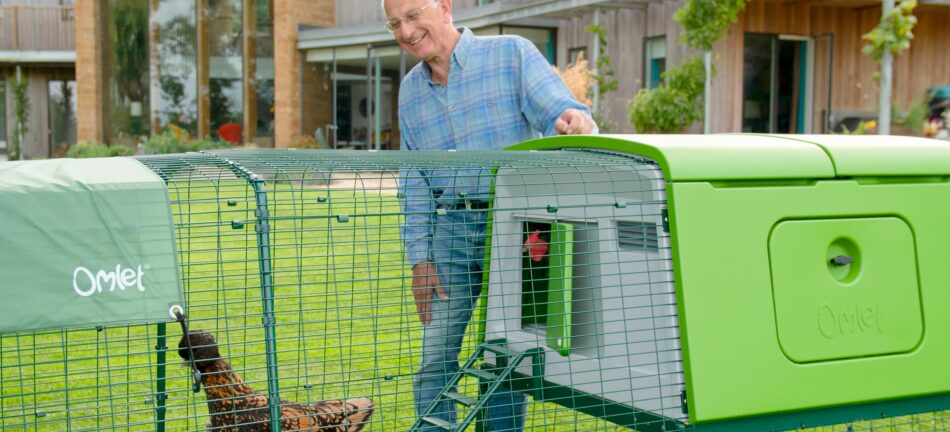

This entry was posted in Chickens
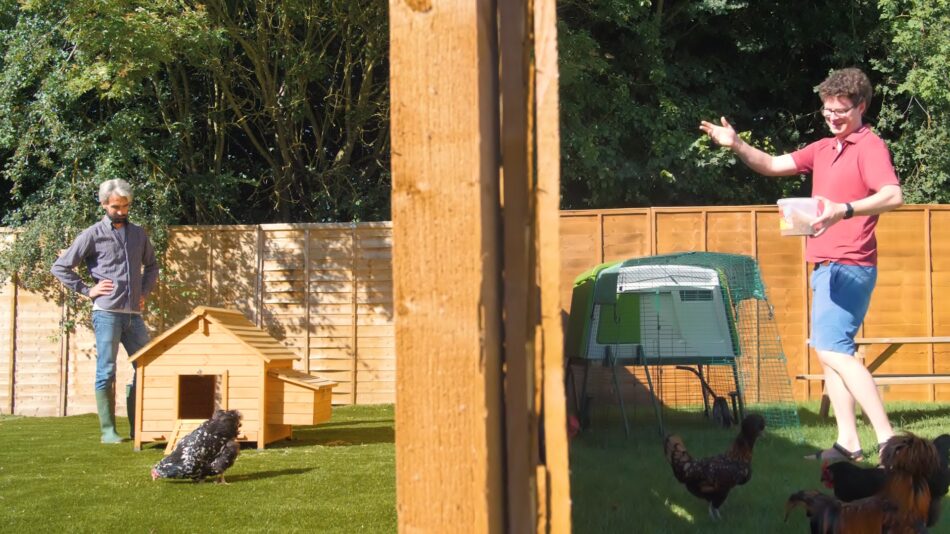
Worried about your chicken coop rotting? It’s a valid concern that all chicken keepers have. Chicken coops are out in the elements, and can take a beating from the weather and predators. Still, chicken keepers rely on their structural integrity to keep their flocks safe – so what happens when a coop starts to rot?
Thankfully, not all chicken coops rot. Wooden coops all eventually succumb to their exposure to the environment, but there’s an alternative option. We invite you to consider: Omlet’s plastic chicken coops.
Why do wooden chicken coops rot?
Wooden chicken coops, by nature, break down over time. No matter how “weather-treated” boards, planks, and roofs may be, they will eventually decompose when exposed to the relentless elements. This is especially true in areas that receive a lot of humidity and severe weather. A constant battering from rain storms, followed by intense sunshine will leach out the weather protectants that lumber may be treated with. Wind and rain will also loosen or warp shingles on chicken coops, making coops drafty and wet. Once the weather has stripped wood of its protectants, moisture sets in, and the wood begins its rotting process.
Wood that stays damp rots the fastest. Wet wood swells and expands, which allows for more moisture to make its way in. And, when exposed to the sun, swollen wood begins to contract when it dries. Through this process of swelling and contracting, wooden chicken coops begin to lose their shape as the boards or planks warp. You may notice bowed or split wooden components on your chicken coop as a result, which will eventually break or collapse. Different types of wood experience this process at varying speeds, but most commercially bought wooden chicken coops are made from lower-quality wood with a shorter lifespan.
Once the wood of a chicken coop begins to rot, any affected boards will need to be replaced. It’s important to address any rotten pieces of a chicken coop immediately to avoid adverse health effects on your chickens. Rotten wood attracts mites and other parasites that will plague your hens, and mould or mildew is often present in damp wood. These fungi can cause respiratory problems in your chickens, and creates unsanitary conditions for both you and your flock.
How to prevent your chicken coop from rotting
Oftentimes it’s easier to build or purchase a new chicken coop from scratch than to renovate a rotten one. Repairing a rotten chicken coop is costly and time-consuming, and will likely need to be repeated throughout the lifetime of a wooden coop. There are preventative measures you can take to maintain a wooden coop to help improve its longevity, but these too take effort and resources.
Repainting, staining, or weather-treating a wooden chicken coop
To help prevent wood rot, wooden chicken coops can be repainted, stained, or weather-treated regularly – usually on an annual basis. Take great care to select products that are non-toxic to chickens, and allow for ample drying time between coats before allowing your hens back into their house. Natural products such as tung oil can be applied to wooden chicken coops to make them water-resistant, but 100% pure tung oil can be costly.
Keep your coop covered
Another method to help prevent wood rot is to keep your chickens’ coop covered. This could be through the use of a tarp, inside of a structure such as a shed or a barn, or by building a structure over the top. It may seem a bit redundant to cover a chicken coop that is meant to protect your flock from the elements, but shielding a wooden coop from sun and moisture can help preserve its components. This isn’t the most convenient option, and application of water-resistant products will still be needed on occasion to protect the exterior of your coop.
Forgo a wooden coop
By far the easiest option to avoid having to fix a rotten chicken coop is to purchase a plastic chicken coop. Omlet’s Eglu Cube chicken coop is made of heavy-duty plastic that’s weather and waterproof, so there’s no concern over rotting components. Truly a zero-maintenance solution, the Eglu Cube is ready to house a flock of up to 10 small breed hens from the time it’s assembled. Omlet’s design is meant to last a lifetime, which means no breaking down or rotting, and no application of preservatives is required to keep your Eglu Cube sanitary and functional.
Why do plastic coops not rot?
The short answer as to why plastic outlasts wood is: because plastic does not exist in nature, naturally occurring organisms are not effective at breaking it down. Wood exists in nature, so there are bacteria and other living organisms that are equipped to dispose of it. Plastic, on the other hand, has no “natural” foes.
Plastic chicken coops do not rot or lose their shape in the elements and do not require routine maintenance. They’re also much easier to clean, offer a more sanitary environment, and are able to be moved with ease compared to their wooden counterparts.
How to maintain a plastic coop
All Omlet products are designed to last, but you’ll still want to check in on your chickens’ coop routinely for any signs of wear and tear. Usually, any doors or parts that are not aligning properly are the result of the soil beneath the coop shifting, and can easily be corrected by moving the coop by a few inches as needed. Chicken run clips may also come loose during these shifts, and should be checked regularly.
Aside from checking your coop for shifting, you’ll also want to clean your coop regularly to keep it fresh. Even deep cleaning the Eglu Cube takes mere minutes, as compared to several hours of cleaning a wooden chicken coop. A pressure washer or high-powered water hose makes the process go even faster. Simply remove the droppings tray and roosting rack, spray clean, and wipe dry.
Compared to wooden chicken coops, maintaining the Eglu Cube saves countless hours each year. And, a coop that’s so easy to clean and maintain creates a much more sanitary environment for your hens, which cuts down on illness and discomfort brought about by the weather. Keeping chickens has never been easier or more enjoyable than with an Omlet coop.
Omlet and your chickens’ perfect home
A rotting chicken coop is a frustration for chicken keepers that we sought to put an end to. The result is our line of high-quality chicken coops that stand the test of time. Combine your Eglu Cube with a Walk In Chicken Run for the ultimate chicken-keeping experience. And, with accessories such as the PoleTree Customisable Chicken Perch or Caddi Chicken Treat Holder, you’ll be able to foster and enjoy watching your hens fulfil their natural behaviours.
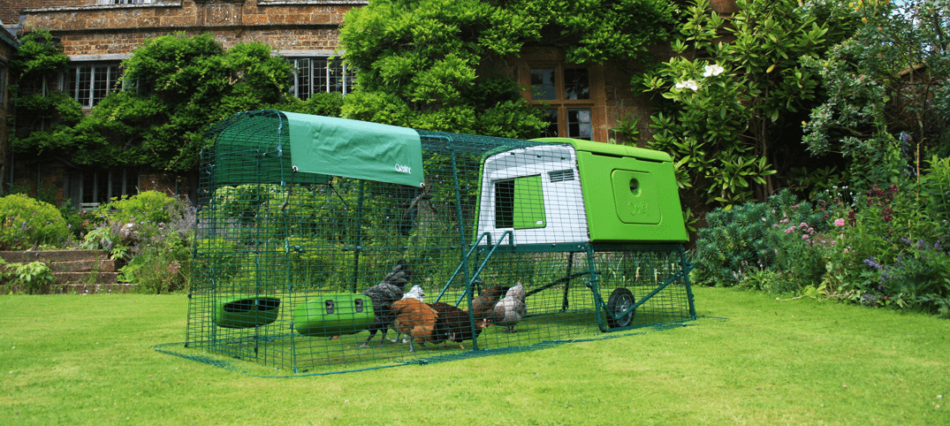

This entry was posted in Chickens
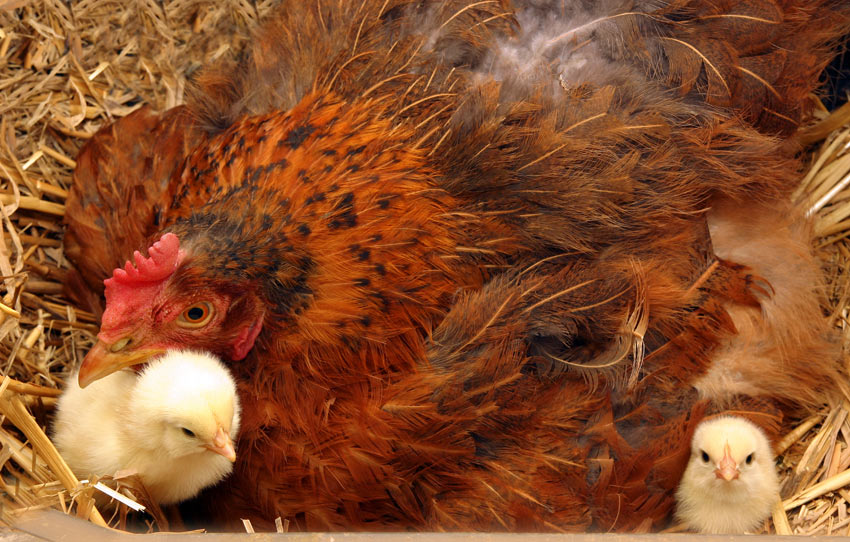
Wondering when your brooder-raised chicks can go outside? Raising hens from chicks is an exciting endeavour, but deciding when it’s safe to transition them to the outside world can seem daunting. As with most plans, timing is key! We’ve taken the guesswork out of transitioning chicks from a brooder and into their forever coop and run. With the help of a comfortable chicken coop and the knowledge to follow, you’ll gain the confidence to know when and how to safely move your chicks outside.
At what age is it safe for chicks to go outside?
If you’ve had your chicks since they hatched, or got them shortly after, you’ll recall how soft and fluffy (and adorable) they looked. The “downy” feathers that give a chick their fuzzy appearance don’t stick around for long. You’ll soon notice your once fluffy chicks start to look a bit bedraggled. This perfectly normal (while unsightly) phenomenon is simply the process of your chicks’ adult feathers growing in. In general, you should see these adult feathers start to peek through sometime between 7 and 14 days old. There are multiple factors that will determine how quickly a chick grows their adult feathers such as:
- Breed
- Diet
- Temperature
- Care
Once you’ve noticed these adult feathers mottling your chicks’ fluff, it’s time to start slowly decreasing the temperature of the brooder. Aim to reduce their heat by 3°C each week until the brooder and the ambient temperature are the same. This gradual decrease in temperature will further aid in their transition to life outside.
By the time your chicks reach 5 weeks of age, they’ve officially entered their “teenage stage.” They may sport a convincing set of adult feathers, but like most teenagers, are not quite mature enough for the outside world! Once your “teenage” chicks reach 6-8 weeks of age, it’s time to consider letting them fly the brooder in favour of some supervised outdoor excursions.
3 essential factors to consider when taking chicks outside
To help you determine if your chicks are ready to spend any amount of time outdoors, ask yourself:
- Do my chicks have all of their adult feathers?
- Is the weather above 15.5°C?
- Will they have a fully enclosed space?
When your chicks are fully clothed in their adult feathers, they can withstand temperatures as low as 15.5°C. Sunny days are always best for outings with your chicks, and it’s important that they stay dry in order to help them regulate their temperatures. A fully enclosed chicken run is essential for outdoor visits – especially if you’re unable to stay with them the entire time.
Temperature and climate considerations
Timing is key when moving your chicks from their brooder to their coop and run, but if your chicks are at least 6-8 weeks old, they’ll be able to tolerate cooler temperature dips. If you have a chicken tractor, you may want to move it around to follow the sun to help your chicks transition from artificial heat to natural heat. And, if your area experiences frequent weather fluctuations in the colder months, you can add extreme weather protection to your chicks’ coop to ensure they stay cosy overnight when they are most vulnerable.
If you’re letting your chicks out during warmer months, a raised chicken coop offers additional shelter and shade. Like adult chickens, chicks can become overheated in warm climates. Be sure to have plenty of fresh water available, and use chicken run covers to provide ample shaded areas.
Predator protection for chicks
Once your chicks are spending large stretches of time outside, it’s not always feasible to monitor them. A safe chicken coop and predator-resistant walk in chicken run are essential not only for housing hens, but for introducing chicks to the outdoors as well. Chicken predators are mainly active at night, but there are those that would not pass up an opportunity for chicks during daylight hours.
Consider giving your chicks plenty of places to “hide” if they get overstimulated. Simple structures such as upturned cardboard boxes with entrances cut into them, or other DIY hides are sufficient. And while your chicks might not be big enough to fully utilize chicken perches, Omlet’s Freestanding Chicken Perch has easy height adjustable perches to give your chicks an opportunity to practice their climbing skills.
Mother hens
Some chicks are hatched and raised naturally under their mothers. Hens can go “broody” (sitting on a clutch of eggs to hatch) any time of the year, but will usually attempt to hatch eggs in the spring. If your hen is broody in the winter, it’s best to discourage her by collecting eggs daily, as chicks hatched in the winter will have a harder time than those hatched in the warmer months. If your location experiences mild winters, hens can successfully keep chicks warm in below-freezing temperatures, but will need to be monitored to ensure that the chicks aren’t being left unattended for too long when the hen goes to eat or drink.
Nature will take its course when chicks are left to be raised by a hen. Hens will provide warmth to their chicks even after they hatch, making them the “brooder.” Good mother hens instinctively know how long their chicks can withstand the absence of heat, and will help their young adjust to the ambient temperature.
If your hen hatched chicks in an elevated chicken coop, consider moving both the hen and chicks to a ground-level chicken coop to avoid chicks accidentally falling while following their mother. Alternatively, you can remove the hatched chicks from the hen once they are dry and place them in a brooder.
Taking chicks outside during the day
If you’ve been decreasing the temperature of the brooder, your chicks should be comfortable outside in temperatures as low as 15.5°C by the time they are 6-8 weeks old. For successful outdoor excursions with your chicks, choose days that are sunny and warm. Start with short visits to your chicken pen and let them hop and scratch around.
Every chick is different, but expect to see hesitation or uncertainty from your chicks at first. The feeling of grass under their feet is much different from the straw, shavings, or flooring of their brooder. The outdoors hold many sights, sounds and smells that are foreign to brooder-raised chicks, so start with short visits to avoid overstimulating them. Aim for 10-15 minutes once or twice a day to help build your chicks’ confidence. Be sure to stay with your chicks during these first few visits to see how they react to their surroundings.
After several days of short visits, increase outside time by 10-15 minutes every couple of days, keeping the weather in mind. Before long, your chicks will be spending many daylight hours getting used to their permanent home. If you haven’t already, now is the perfect time to start letting your chicks out in their coop and run during their outdoor time.
Checklist for permanently moving chicks outside
Your chicks are fully feathered, have successfully completed outdoor trips to their new home, and are thriving. It’s time to make the move permanent! Make sure the following are met before moving your chicks outside full-time:
- A safe chicken coop that your chicks are comfortable accessing
- An attached chicken run reinforced with additional predator-resistant measures
- Feeders and waterers placed at appropriate heights for your chicks
- Outdoor temperatures of 15.5°C or higher, even overnight
- Your chicks are at least 6-8 weeks old
If you are moving your chicks to an Eglu chicken coop, the recommended age is 12 weeks old. This gives them ample time to grow into a size that is appropriate for the design of Omlet coops. Roosting racks and coop ladders may pose a challenge to chicks under 12 weeks of age, and the wire spacing of the run was designed with larger chicks in mind.
Can chicks be outside with other hens?
If your chicks will be joining other hens, follow the same steps as you would when introducing new chickens to your flock. Quarantine periods need not apply to chicks you’ve raised yourself in a brooder, as you would see signs of illness during that time. However, you’ll want to introduce chicks to their future flock-mates slowly to minimise the risk of injuries. A chicken pen placed inside or next to your existing flock will allow your chicks to visit your other hens safely.
As always, hens have to establish a pecking order, regardless of how many times they’ve seen each other through a barrier. Always monitor the first encounter when introducing new members to a flock. Quickly remove any chicks that hens appear to pick on, and consider housing them or any aggressive hens separately until your chicks are bigger.
Winter considerations for letting chicks outside
Most chicken keepers will agree that spring and early summer are the best months to move their chicks outside. However, with some climates experiencing dreadful cold for over half of the year, it can make spring chick-raising slightly more difficult. In these situations, it’s best to keep your chicks in their brooder for as long as possible – ideally, until they are 12-16 weeks old. If your chicks are too large to stay in the brooder for that long, be sure to take extra precautions against the cold. Prepare your chicks’ coop and run for the winter as you normally would for adult hens, trusting that your Eglu keeps your chickens warm. Additional weather protection for your chicken coop can be added to provide extra insulation.
Are my chicks too cold?
The same signs of chickens being too cold apply to chicks. Check-in on your chicks routinely and monitor for any signs of them getting too chilly, such as:
- Lethargy
- Huddling together
- Standing with one foot off of the ground
- Discolouration of combs, wattles, or feet
If you notice any of these in your chicks during cold weather, bring them inside promptly. Do not warm them up too quickly, as this can cause them to go into shock. Only use a heat lamp if their inside area is in a drafty space such as a garage or barn. Indoor temperatures above 18°C will be adequate to slowly warm up any overly-chilled chicks. Keep them inside until they are eating and drinking normally, and plan to let them back out when the outdoor temperatures stabilise.
When chicks should not go outside
There are some circumstances where chicks should not be transitioned outdoors. These include:
- If your chicks are less than 6 weeks old
- Sustained temperatures below freezing if your chicks are less than 12 weeks old
- During heavy rains or extreme weather
- If your chicks cannot easily access their coop
Always check your weather forecast to get an idea of temperatures and precipitation for the week you plan to permanently transition your chicks outdoors. If heavy rains are expected, or any other significant weather events are, postpone until conditions improve. Wet chicks, just like their adult counterparts, have a hard time regulating their body temperatures when they’re wet.
Some chicks get the hang of a chicken coop ladder quickly, while others may struggle to perfect this technique. If you notice that some of your chicks are unable to use a ladder, create a ramp to lay on top of the ladder rungs. Once they’ve gotten the hang of using their growing feet, you can remove the ramp.
Lastly, consider avian flu and its prevalence in your area. Chicks are just as much at risk for contracting avian flu as adult hens, but by using waterproof chicken run tarps to prevent droppings from wild birds, you can greatly minimise that risk.
Omlet’s award-winning chicken care products
Omlet aims to help you succeed in all of your chicken-keeping endeavours, including supporting you in your journey of raising hens from chicks. Large chicken coops help accommodate your growing flock, and mobile chicken coops help move your chicks even closer to you for supervision, or to get them closer to their future flock-mates. Our hen houses make excellent first-time homes for chicks, keeping them safe and comfortable in all climates.
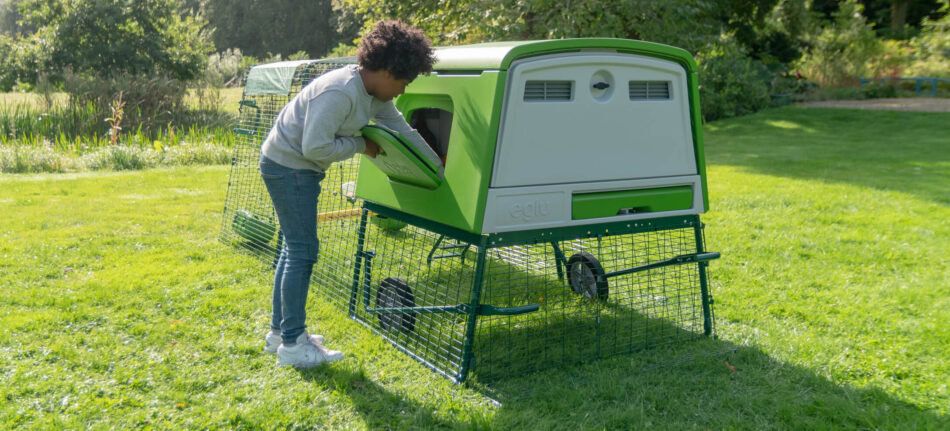

This entry was posted in Chickens
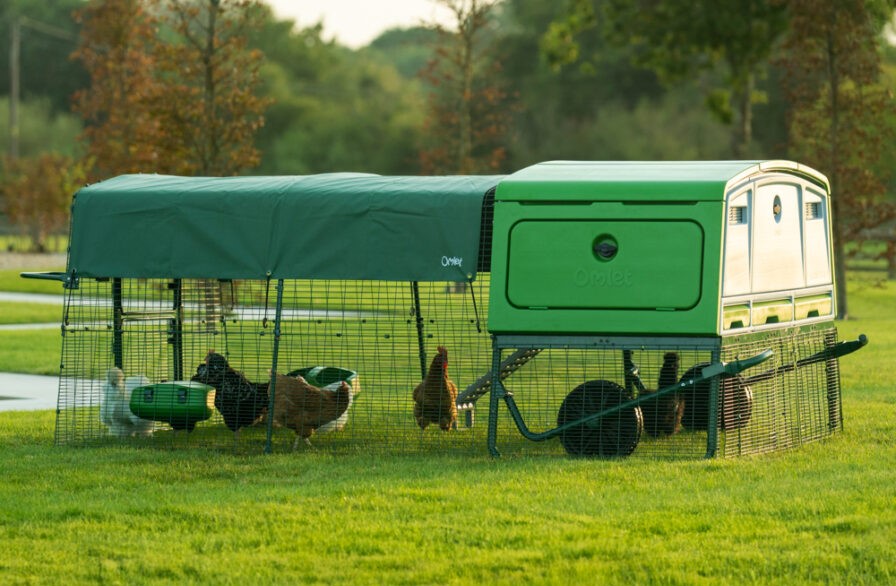
Wondering how to choose the right chicken coop size for your flock? Your hens’ home will need to safely and comfortably house them, and you’ll want to be sure that you get the right size for the number of chickens you have. Appeal to all of the Goldilocks in your flock with our tips and coop sizing. Find your perfect coop that’s not too big, not too small but just the right size.
The importance of the right size coop
Chicken coop size is important because hens need adequate space to roost at night and lay their eggs. Chicken coops with dedicated egg-laying areas are ideal so that your hens have a place to rest and a place to nest. This keeps your eggs clean and free from being smashed by roosting chickens.
Your chickens’ coop should be large enough for your hens to feel comfortable and safe. Keep in mind that your hens’ house will mainly be used to sleep in at night and to lay eggs. Your hens will play, forage and be active outdoors, so their coop will only need to be large enough to maneuver into roosting or laying positions comfortably.
It’s also important to not get a coop that’s too large – especially in colder climates. Hens huddle together during chilly weather, and a smaller coop will help contain their body heat within. If you know that you’re limited to keeping 3 or 4 hens, it’s best to go with a smaller chicken coop. But if you plan to keep more than 4 hens, their body heat will fill the space of a larger chicken coop.
How much space is needed per chicken
There’s no exact formula for determining how much space to give chickens, and chicken coop sizes can vary. Different breeds of chickens have varying space requirements, and each individual hen will have their own opinion of how close they prefer to be during roosting. As a general rule, you’ll want to provide your hens with as much space as possible. This will allow ample space for your existing flock, as well as room to grow. The phenomenon “chicken math” plagues most chicken keepers when trying to calculate coop size per chicken. This is a term used when flock raisers acquire more chickens than they originally intended to. So, it’s always a good idea to get the biggest chicken coop you can for your space, should chicken math creep up on you.
Some cities or states may require specific dimensions for your chicken coop based on the number of hens you have. Check with your city’s zoning department to see if there are size requirements or restrictions before choosing your chicken coop.
Elements to consider when deciding the perfect size chicken coop
Before settling on your chicken coop size, make sure you consider the following:
- Your city or homeowners association’s (HOA) size requirements or restrictions
- How many hens you’d like to keep
- Your garden’s space
You’ll also want to consider if you want a mobile chicken coop or one that you’ll keep in a permanent location. Mobile chicken coops are great for letting your chickens help mow your lawn, and are particularly helpful in areas that experience severe weather events. They can be moved to safety quickly and easily – while your flock remains safely inside.
Chicken coops placed in a permanent location will need a chicken run or chicken fencing to be attached to or placed inside. This will allow your hens time outside of their house in safety, and keep them from areas you’d rather not have them pecking around in.
Choosing your chicken coop comes down to personal preference. Most chicken keepers would agree that having a chicken coop that’s easy to clean is at the top of their list when it comes to selecting a chicken coop. Your ideal chicken coop size should be one that fits your needs and fits your flock inside.
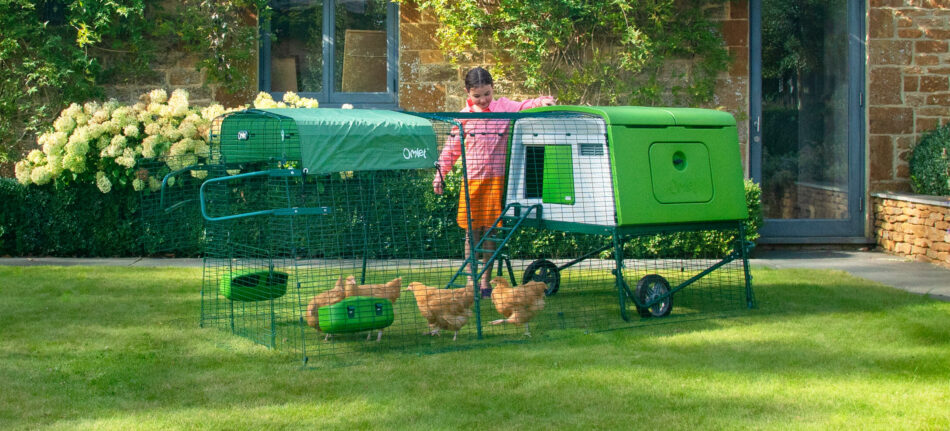
Finding the right coop for your flock size
If you’ve already decided on which breeds of chickens you’re going to keep, it’s time to determine how many you want to have. If your city or HOA has restrictions on how many hens you can have at any given time, then the decision has been made for you. There are different sizes of chicken coops depending on how many hens you will be housing.
Eglu Pro provides the most amount of space. This extra-large chicken coop is perfect for:
- Flocks of up to 15 chickens
- Chicken keepers wanting to grow their flocks
- Both mobile and permanent setups
Larger flocks can be also housed in one of our large chicken coops. The Eglu Cube is recommended for:
- Flocks of up to 10 small breed chickens
- Chicken keepers with flock size restrictions
- Bigger flocks on smaller lots
There are still other different types of chicken coops to consider. Those with small flock restrictions can easily choose from our chicken coops that house 2-4 chickens:
- The Eglu Go
- Perfect for those needing a low-profile chicken coop, or that keep hens that prefer roosting at ground level
- Can also be used as additional housing for sick or injured hens
- The Eglu Go Up
- Ideal for those wanting an elevated coop
- Can be converted into a mobile chicken coop easily with the addition of handles and wheels
How to increase the size of your current chicken coop
At Omlet, we have firsthand experience with chicken math. Expanding your flock’s space will likely be an ongoing endeavour. After all, unless your city or HOA says otherwise, you can never have too many chickens.
Our walk in chicken runs can be extended indefinitely to accommodate your growing flock. Simply choose your ideal dimensions using our online configurator, and attach the corresponding run extension to your existing walk in run. Our attached chicken coop runs can also be extended to up to 12 feet.
Add extra chicken coops for sleeping and laying space within your growing run. The addition of any of our Eglu chicken coops will offer lodging to your growing flock. Create different areas of your chickens’ area with chicken run partitions, which can separate your flock by breed, size, or temperament.
First-time chicken-keeping tips
Ready to get started keeping chickens? Once you’ve determined your coop size, here are some other things to check off before making the poultry plunge:
- Research what type of diet you will feed your hens. This could be regular laying feed, organic, non-GMO, or free-range pellets or crumbles.
- Decide if you want to start out with hens or chicks. There are pros and cons to each, but chicks will require additional equipment and care for the first 6-12 weeks of their lives.
- Prepare your yard and measure where you want your chicken flock’s home to be. This can help you determine if you would prefer a mobile or permanent setup.
The perfect size with Omlet
Choosing the chicken coop size that’s right for you is a big decision. But with Omlet, you can be sure that no matter the size of the coop, you’ll be getting a hen house that’s been designed to last a lifetime. All of our chicken coops are built from the same heavy-duty, rot-free materials. Add some finishing touches with a Freestanding Chicken Perch or the Chicken Swing to help your flock enjoy their space to the fullest.
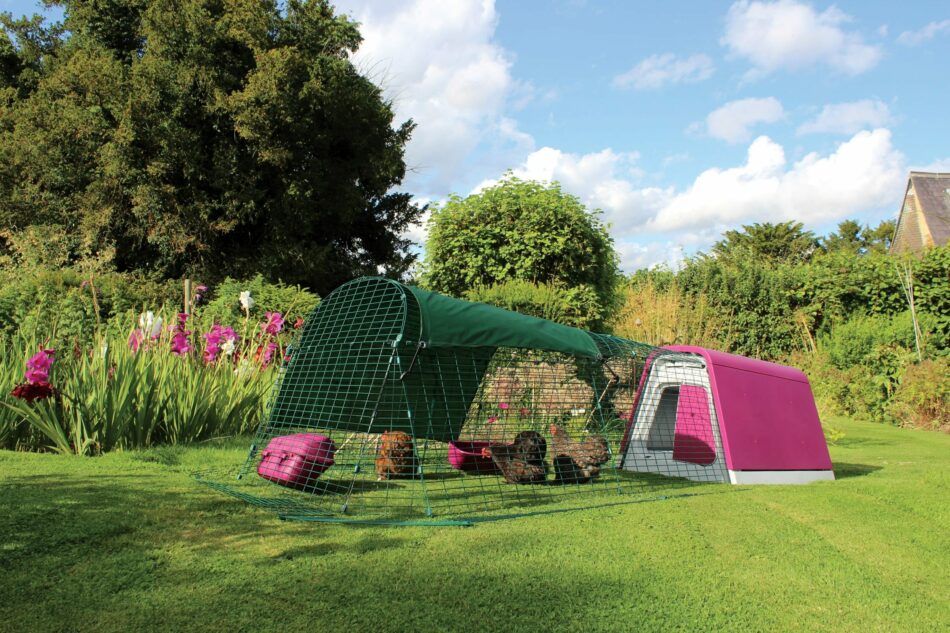

This entry was posted in Chickens
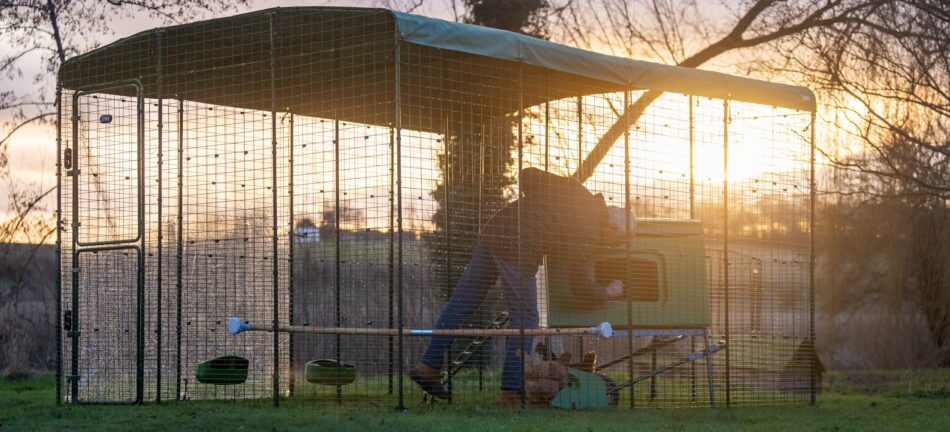
Daily chicken care can be an enjoyable activity. More of a hobby than a chore, caring for your flock should be something you look forward to every day. Chickens are relatively low-maintenance animals, but like all pets, require daily care to live their best lives.
Wondering what a day in the life of a chicken keeper looks like? We’ve compiled sample schedules that showcase how Omlet makes tending to your flock easy and enjoyable.
Morning chicken-keeping care
What if you could clean your chicken coop in the same amount of time that it takes you to prepare your morning cup of coffee or tea? With the Eglu Cube Chicken Coop by Omlet, you can! Your flock’s morning care routine couldn’t be easier or more efficient than with the Eglu Cube. Not only is our chicken coop easy to clean, but the included feeders and waterers hold plenty of sustenance for your flock to get them through the day.
Imagine if you will, a typical morning chicken care routine for a keeper with an Eglu Cube…
- Your day may start around 8:00 am. You’ll want to let your hens out to seize the day and open up their nesting partition door once they’ve vacated the coop.
- Then it’s time to clean the chicken coop out, but since you’ve got a sophisticated, easy-to-clean coop, it’s no problem. You’ll remove the droppings tray, and dump it in your compost pile or garbage.
- You’ll then want to spray or wipe the droppings tray and removable roosting rack clean if needed.
- Time to refresh the bedding in the tray, and replace the now-clean components back into the Cube.
- Finally, you’ll just need to top off your flock’s feeders and waterers for the day.
These tasks only take minutes for you to finish – likely before your coffee pot or tea kettle is done with your morning pick-me-up.
Afternoon chicken-keeping care
Your mid-day chicken check-in can be quick and easy. Hens usually lay eggs during the late morning and early afternoon hours, so mid-late afternoon is prime time for collecting cackleberries. The Eglu Cube has a convenient access door on the side that opens directly into the nesting area for quick egg-collecting.
Afternoon is also the perfect time to watch your hens in action. If you provide them with an assortment of chicken toys and accessories, you’ll be able to observe them play, peck, and perch throughout the day. Our customizable PoleTree Chicken Perch is perfect for your hens to catch a view of the world from an elevated place, or to take a quick nap in the afternoon sunshine.
When you head out to check for eggs, consider taking your flock a snack in the Caddi Chicken Treat Holder. This unique treat dispenser elevates snacktime and is great for keeping the floor of your flock’s run clean and tidy. Serve up fresh veggies or leafy greens to supply your chickens with enrichment and nutrition.
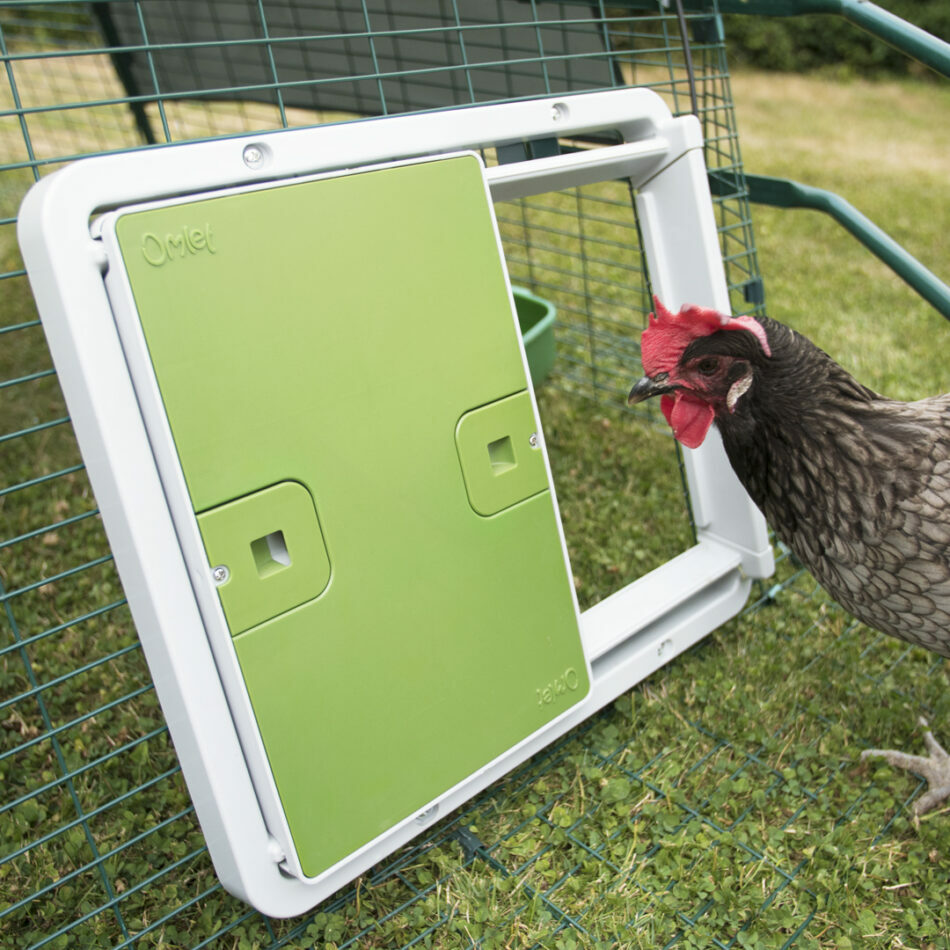
Evening chicken-keeping care
When daylight dwindles, it’s time to wrap up your flock’s day. For maximum safety, close the door to the coop overnight. If you aren’t home to tuck your hens in, consider adding an Automatic Chicken Coop Door.
The Autodoor in action:
- The Autodoor can be programmed with the clock or the sun to keep your flock on schedule – with or without you being home.
- Sophisticated safety sensors prevent the Autodoor from closing on any hens that are crossing or sitting on the threshold of the Eglu Cube.
- The sideways opening mechanism increases flock safety by making it difficult for predators to pry the door open.
Imagine how simple your evening routine would be with an Eglu Cube:
- You’ll close your hens in at dusk, or just after dark. If you’re using an Autodoor, you may just take a nice evening walk and check to make sure all of your hens made it in for bedtime.
- As a matter of personal preference, you may want to slide the nesting area partition door closed to prevent hens from roosting in it overnight.
- Finally, you’ll probably want to collect and store your flock’s leftovers to reduce raids from rodents.
And just like that, your flock is tucked into their comfy coop for another night of restful sleep.
Housing your hens in an Eglu Cube keeps them safe not just overnight, but during storms and predator attacks as well. But just how sturdy are Eglu Cubes? Strong enough to withstand attacks from a bear, hurricanes, tornadoes, and falling trees. Sleep easy at night knowing your flock is being fully protected when they’re secured in their Eglu Cube.
Omlet and chicken care
Omlet’s chicken-keeping experts have made tending to flocks easier than ever. Not only are our products safe and durable, but they’re easy to clean and a joy to use. Lighten your workload and treat your hens when you add an Eglu Cube, Autodoor, and PoleTree to your chickens’ setup.
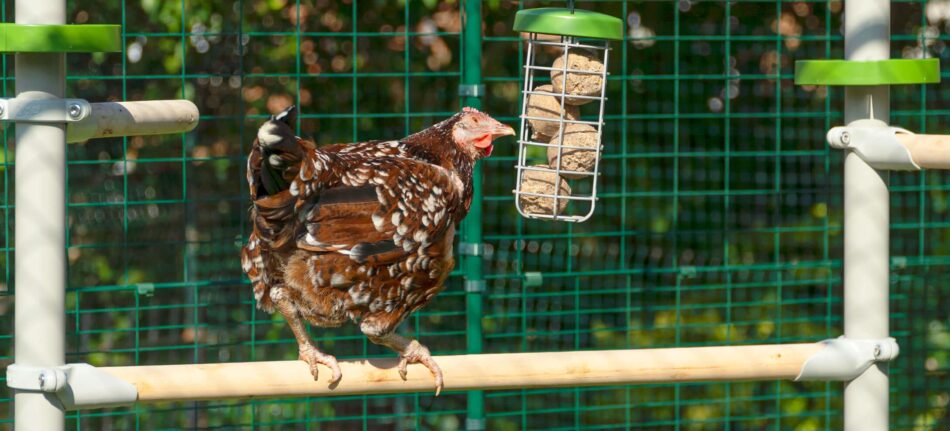
This entry was posted in Chickens
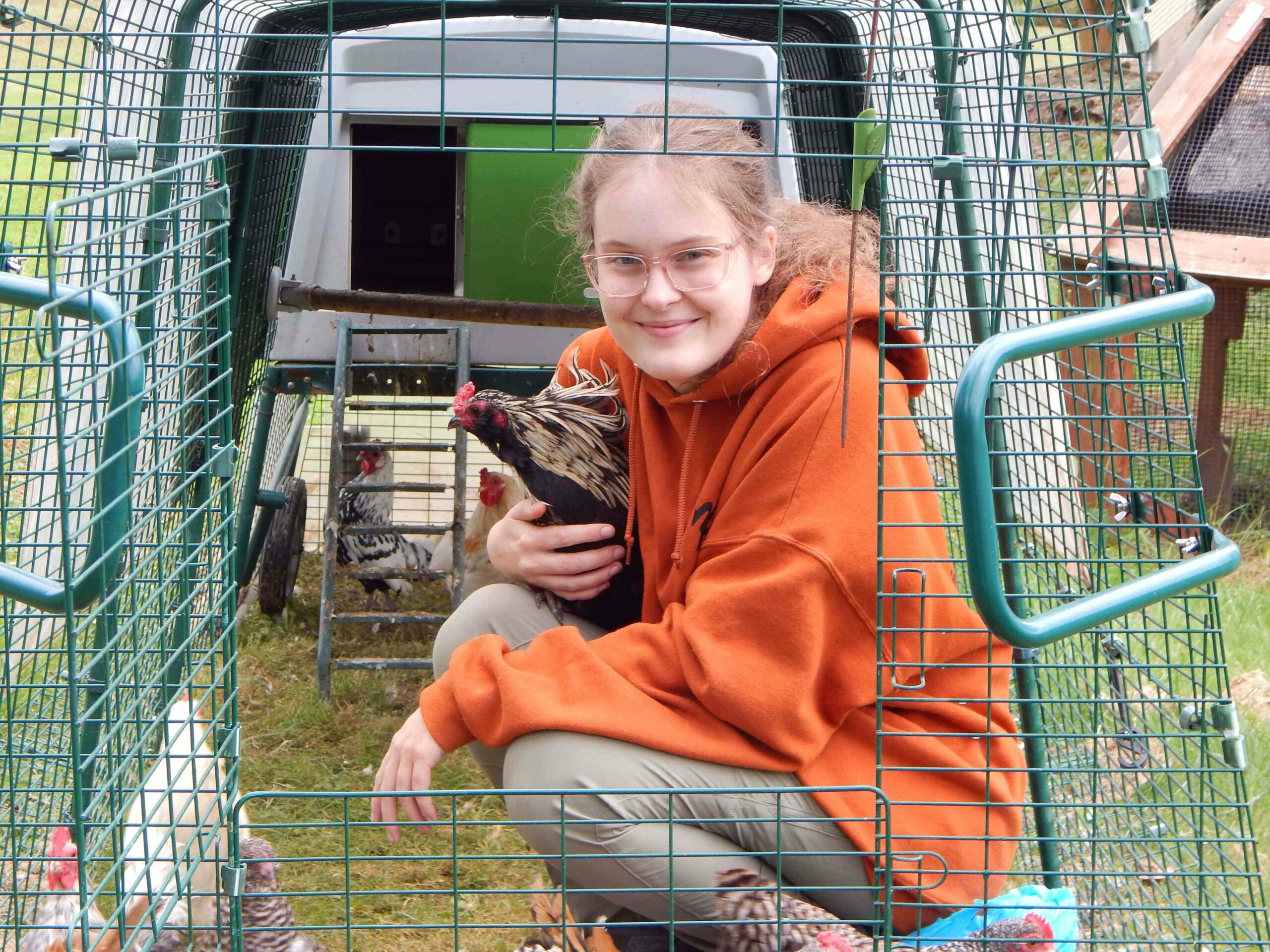
Rose is a chicken fanatic who’s been building her poultry empire since the tender age of thirteen. As an adult, she now turns her extensive poultry knowledge into how-to’s and guides for other chicken lovers, both young and old. Today, Rose owns and runs littleonionfarm.org, where she writes about self-sufficient lifestyles and shares her life on her Pittsburgh, PA, USA homestead.
Many people consider chickens to be the “gateway drug” to self-sufficient living, and for good reason. Chickens are easy to keep, easy to acquire, inexpensive (at least as far as livestock goes), and come with a variety of benefits. It stands to reason, then, that most chicken owners eventually get the itch to expand their flock once it’s established. This well-known phenomenon has come to be fondly known as “chicken math.”
Of course, some backyard chicken owners – myself included – don’t just stop with chicken math. Eventually, it becomes garden math, quail math, duck math, and then you end up with a homestead (I have no regrets).
Anyway, why would you want to expand your chicken flock? What kinds of benefits do chickens provide that would make you want more? And what can you do to prepare for when chicken math inevitably strikes?
Why chicken math?
Why do so many people end up buying chickens, only to end up expanding their flock later? I usually see a few recurring culprits that people fall victim to. The one that got me was the huge variety of chicken breeds available for us to enjoy. Chickens come in just about every shape, size, and color imaginable, and different breeds often have different personalities, too. My Golden Penciled Hamburg hen, for example, is on the flighty side – she’s not a cuddler – but she loves scratch grains with a passion, and has a particular appreciation for my Poppy Peck Toy.
Of course, the same things that make chickens a “gateway drug” also make expanding your flock easy – sometimes too easy. I started with a small flock of just eight hens when I was a child, which quickly became twelve hens… which then became a second chicken coop, and fifteen more chickens, and a few roosters… (you get the picture).
That being said, chicken math isn’t always a bad thing, as long as your birds (and you) continue to be happy and healthy. Your flock can become quite large before it becomes difficult, time-consuming, or expensive to care for. The cost of owning chickens does go up somewhat as you get more – especially food and housing costs – but I find that, even with a large flock, chickens’ cost of care exists in a “sweet spot” that makes them attractive for both experienced homesteaders and newbies alike.
Finally – on a more specific note – one of the most common reasons I see fellow chicken keepers expanding their flocks is because they want colourful eggs (or more eggs in general). While each hen will only lay one colour egg her entire life, different hens can lay eggs in chocolate brown, medium brown, light tan, bright blue, sage green, dark olive, and, of course, white. Some hens even lay eggs verging on pale pink or dusky purple, but the exact colour is heavily dependent upon each hen’s breed.
Chicken benefits (besides eggs)
The usual backyard chicken flock provides a few obvious benefits, the main two being eggs and meat. Many chicken keepers also enjoy the companionship and entertainment that their chickens offer. However, that’s not all there is to chickens – not by a long shot!
My main chicken coop is an Eglu Cube with wheels, so I move it around my yard to keep my coop cleaning duties minimal. However, I make sure to save any droppings from the enclosed portion to use for compost. Chicken droppings make a fantastic garden fertilizer, and even if you don’t plan to use them yourself, I promise that a local gardener will be thrilled to take any extras off your hands. Plus, with mobile chicken coops like the Eglu Cube, any manure that you don’t collect will fertilize your lawn. Your grass will grow back greener and fuller than it was before in places where your chickens have been!
Another lesser-known benefit to owning chickens is reducing your food waste. I care deeply about our planet, but even I end up with food that spoils on the counter or in the fridge from time to time. When that happens, my chickens happily break it down for me. Not only does it stay out of a landfill this way, but it adds variety to their diets and gives them enrichment, too.
Finally, chickens provide important pest and weed control to your backyard, especially if you allow them to free range. While a flock of chickens can’t mow your lawn on its own like a goat or cow might, most chickens will happily eat any critters they find in it, including ticks, grubs, earthworms, crickets, and sometimes even mice or snakes!
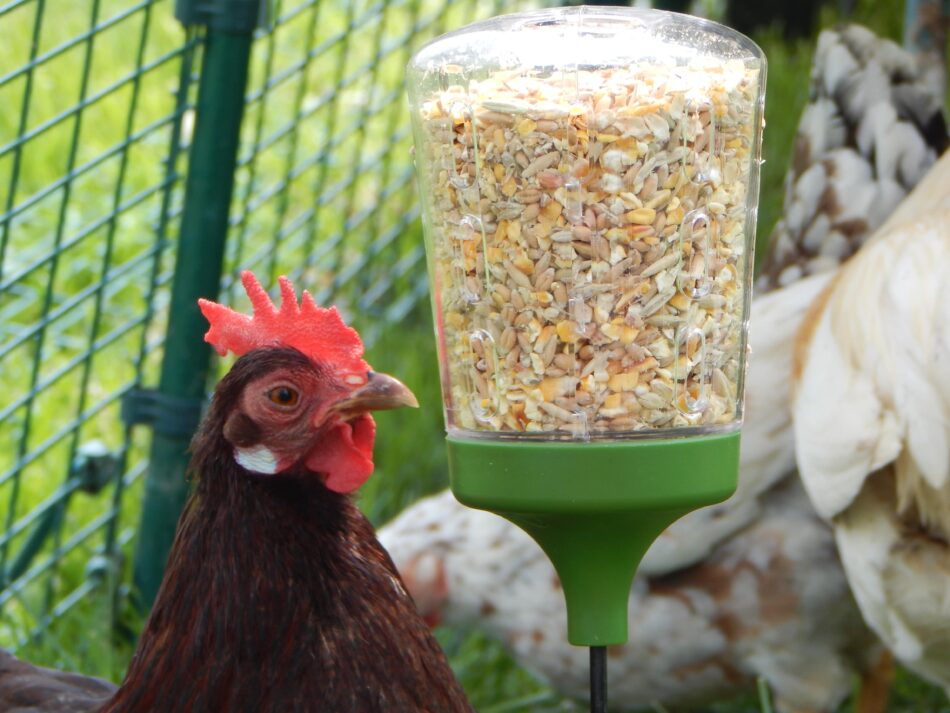
How to mitigate chicken math
What can you do to prepare for chicken math before it strikes? The main way is by buying a chicken coop that’s larger than you think you’ll need. For example, if you think you’ll only want four laying hens – a flock that would be small enough for an Eglu Go – consider upgrading to the Eglu Cube instead. This gives you room to add a few more in the future. At some point, you may still need to get a second coop (I know I did), but a larger coop will at least prevent that for as long as possible.
Another way to mitigate the effects of chicken math is by doing thorough research before you establish your first flock. I know it’s tempting to dive right in and order chicks as soon as possible, but I highly recommend taking a while to research breeds, coops, risks, and future plans before you get started. You can also avoid temptation by staying away from feed stores and poultry swap meets, but I find (from experience) that it’s smarter to plan for the inevitable instead of trying to prevent it!
Finally, make sure you’re familiar with any local regulations on flock size and composition in your municipality. I’m not familiar with other countries’ regulations but in the US state of Pennsylvania where I live, most livestock regulations are left up to the county to decide. However, townships and cities sometimes have their own rules for you to follow, too.
Final thoughts
Were you familiar with the concept of chicken math before reading this guide? More importantly, are you prepared for the moment chicken math inevitably strikes your flock? I’m a huge fan of Omlet’s Eglu Cube for newbie backyard chicken owners, so I never hesitate to recommend it – it’s the perfect size and configuration for a good-sized starter flock.
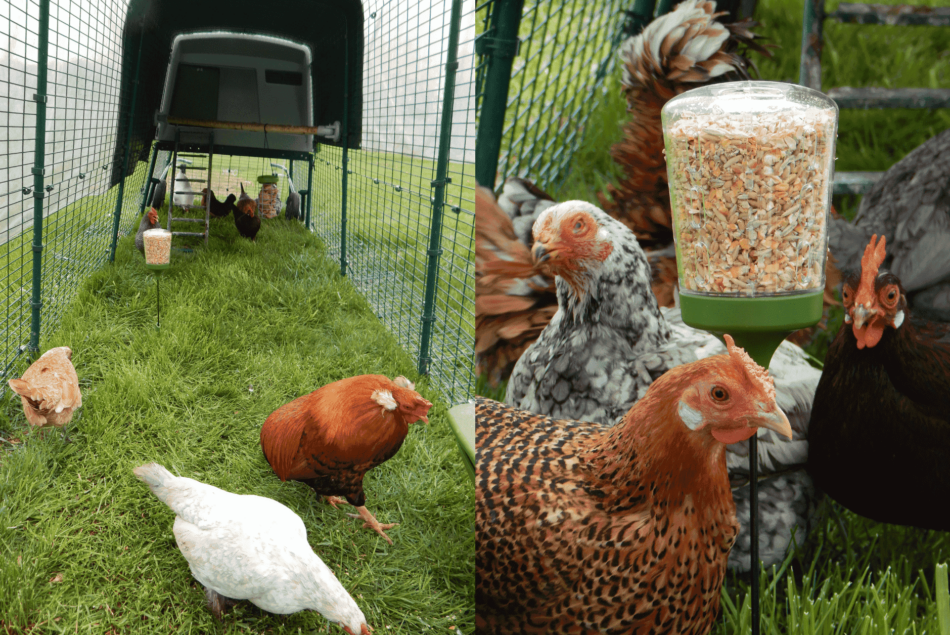
This entry was posted in Chickens
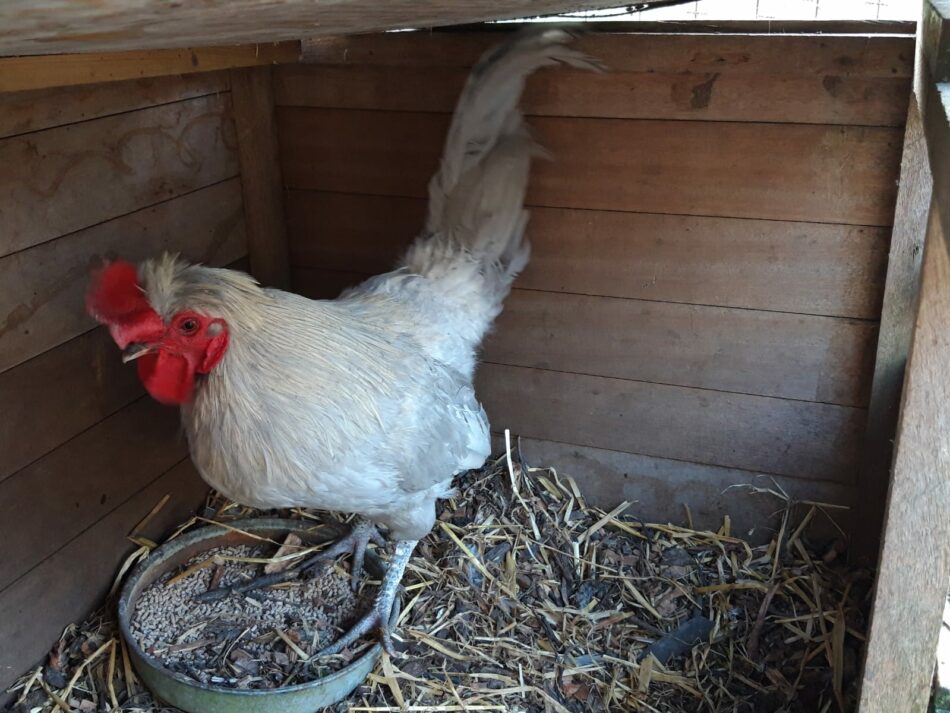
Wooden chicken coops have historically been the most common type of hen houses – but there are several reasons to avoid wooden chicken coops. Many types of wood are inexpensive and help lower the cost of a chicken coop. But, lower costs also mean lower quality. Over time, these cheaply made hen houses need replacing, which in turn costs you more money over the years. Thankfully, there’s an alternative to rickety, cheap, and hard-to-maintain wooden chicken coops. Don’t get caught in the vicious cycle of replacing worn-out wooden coops. Instead, invest in a plastic chicken coop that’s built to last a lifetime.
10 reasons to avoid wooden chicken coops
We’ve outlined the most common concerns when it comes to wooden chicken coops. And, when compared to plastic, there’s a clear winner.
1. Wooden chicken coops rot
Not all chicken coops are created to last. Wooden chicken coops, while less expensive to purchase initially, will eventually rot. Wood is a natural material that’s subject to the elements. Plastic chicken coops will never rot and don’t decompose the way wooden chicken coops do. Omlet’s chicken coops are designed to last a lifetime.
2. Wooden chicken coops are hard to clean
Have you ever scraped the inside of a wooden chicken coop with a putty knife or other flat-edged cleaning device? If you have, you’re not likely to forget it easily! And if you haven’t — you’ll want to spare yourself the experience. Removing droppings and thoroughly cleaning a wooden chicken coop is a very difficult task. Wood will rot faster if cleaned with a pressure washer, and takes hours to dry after getting wet.
Omlet’s plastic chicken coops are incredibly easy to clean. All of the interior pieces can be removed for easy cleaning, and the entire chicken coop is designed to be pressure washed or wiped clean. Get a sparkling clean chicken coop in just minutes with very little drying time.
3. Wooden chicken coops are costly to repair
Wooden chicken coops start to deteriorate as soon as they are exposed to the elements. Their roofs will need shingles replaced, as will rotted or warped boards. Chicken wire or hardware cloth will come loose from staples anchored in flimsy wood and will need to be reinforced. A lot of routine maintenance goes into keeping a wooden chicken coop structurally sound.
Plastic chicken coops require no maintenance or upkeep. Omlet’s chicken coops are easy to assemble, and don’t require replacement parts.
4. Wooden chicken coops aren’t predator-resistant
Chicken predators are something that all flock raisers will encounter at some point. And while wood weakens over time, plastic chicken coops will hold up over the years — making them much more resilient to any break-in attempts from chicken predators.
Add another layer of security to your hens’ home with an automatic chicken coop door. Omlet’s Autodoor opens and closes on a horizontal spiral mechanism that is extremely difficult for predators to pry open. And, with the light and time settings, your flock will be safely closed in each evening before predators are at their most active.
The Autodoor is designed to integrate seamlessly with the Eglu Cube chicken coop, but can also be added onto any chicken run through one of our attachment kits.
5. Wooden chicken coops aren’t waterproof
Wood is porous and gets saturated when it rains. Not only does this lead to rotting, but it also creates breeding grounds for mould and mildew. Spores from these fungi can spell respiratory problems for your flock, and create very unpleasant living conditions.
Omlet’s coops are waterproof and won’t mould, mildew, or rot as a result of rain. And, additional chicken run weather protection will keep your flock stay nice and dry on rainy days in their run. Chickens can enjoy rainy days when they’re covered and have a dry coop to roost in.
6. Wooden chicken coops aren’t insulated
One of the biggest issues with wooden chicken coops is their lack of insulation. Drafty chicken coops can be deadly during winter storms, and downright scorching in the summer heat. Without insulation, your hens’ house will fluctuate wildly along with the weather.
Omlet uses twin-wall insulation methods in our chicken coops to ensure ultimate comfort. Our line of Eglu chicken coops help keep your hens cool in the summer and warm in the winter.
7. Wooden chicken coops have a short lifespan
Replacing your chickens’ coop every few years sounds like a costly endeavour, right? But it’s exactly what you’ll be doing with wooden chicken coops. The best chicken coops are designed to last a lifetime, and can grow with you and your flock.
Omlet’s chicken coops aren’t just long-lasting but have attached runs that can be extended to up to 12 feet long. They also integrate seamlessly with our heavy-duty walk in chicken runs, which can be extended indefinitely.
8. Wooden chicken coops let mites thrive
Mites are a nightmare for chicken keepers and hens alike. They make your flock feel miserable, and are hard to eradicate, as they thrive in moist, dark crevices. Mites are easier to prevent than to treat, and one of the best ways to avoid mites in the first place is to create an inhospitable environment for them.
Avoid mites by investing in a plastic chicken coop. Regular pressure washes or wipe-downs will prevent the presence of these parasites and give your flock a much more hygienic environment.
9. Wooden chicken coops are hard to move
There’s a sense of finality when you set a wooden chicken coop in its place. Once erected, a wooden coop cannot be moved easily. Whether it be from rot or weight from being rained on, wooden chicken coops are not meant to be relocated.
Some wooden chicken coops claim to be chicken tractors (mobile chicken coops), but due to their deterioration in the elements, they become increasingly difficult to move.
Our mobile chicken coops are designed to be moved as often as you’d like, and can be moved with ease by just one person. All of our coops can have wheels and handles added to make moving them a breeze. Their structural integrity holds up against the elements, so you’ll never need to worry about them falling apart.
10. Wooden chicken coops are flimsy
Wooden chicken coops are no match for wild weather events or large predators like bears or coyotes. During storms, roofs can be blown off and boards loosened by battering wind and rain. Predators can easily push through chicken wire or dig under runs.
Omlet’s Eglu Cube chicken coop is strong enough to withstand hurricanes, bear attacks and falling trees. And, all of our chicken runs are made from heavy-duty wire-welded panels that feature anti-dig skirting to help prevent predators from digging into your chickens’ space.
Omlet’s Eglu Cube chicken coop
The winner is clear: the Eglu Cube chicken coop, exclusively by Omlet. But don’t just take our word for it — see why thousands of chicken keepers across the globe trust the Eglu Cube with their flocks. Plus, the Eglu Cube is backed by our 10 year worry-free warranty, and a 180 day money back guarantee. When you choose the Eglu Cube, you’re investing in the only chicken coop you’ll ever need to buy.

Omlet’s plastic chicken coops
Like all Omlet chicken coops, the Eglu Cube has been designed to outlast and outperform wooden chicken coops. With the addition of the Autodoor, your Eglu Cube will be a force to be reckoned with — deterring persistent predators, parasites, and perilous weather conditions. Invest in your flock’s future when you choose an Eglu Cube, and never worry about having to repair or replace your chickens’ coop.
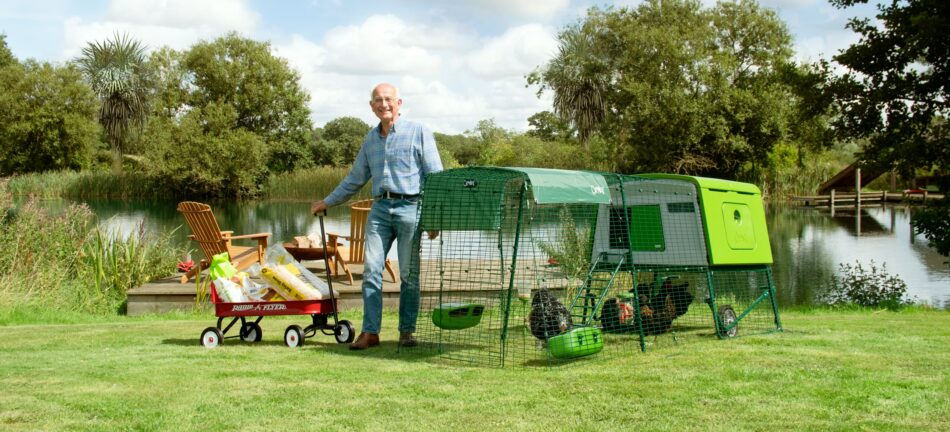

This entry was posted in Chickens
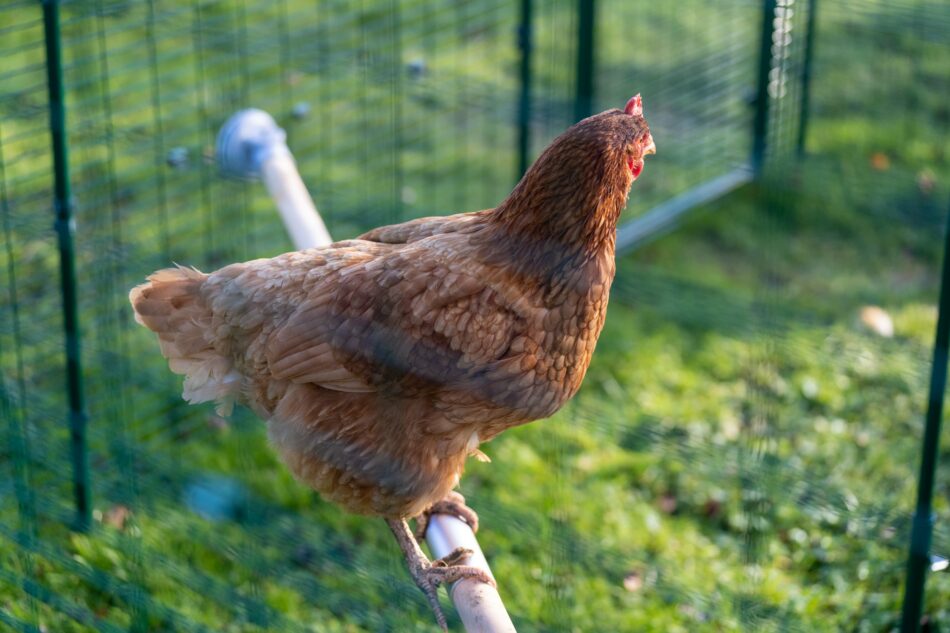
Keeping chickens in gardens has been rising in popularity over the past several years. Once viewed as farm animals, chickens are now gracing the garden of many families living in suburban areas. If you’ve been curious about starting your own flock of chickens, we’re here to equip you with knowledge and products to make keeping chickens a success.
4 reasons to keep garden chickens
Keeping garden chickens is a great hobby that can be shared with the entire family. The relationship between hens and humans is very symbiotic. Chickens are prey animals that need protection from predators, and when provided with care and shelter can thrive in virtually any setting. Hens offer humans companionship, garden pest control, and of course – fresh eggs.
Having chickens in your garden will:
- Provide your family with fresh eggs year-round
- Reduce stress through more screen-free time spent outdoors
- Be a unique pet experience for you and your family
- Teach the value of work and responsibility to children
Garden chicken keepers enjoy watching their flock simply peck the ground and go about their daily routine. You’ll be amazed by how even a small flock of hens can decimate the population of pests like ants, spiders and snails. All that added protein gets converted into delicious and nutritious eggs for you to collect from your chickens’ coop daily.
How to choose your garden chicken coop
Chicken coops are the most important component of owning hens. Your hens’ home will need to shelter them from the elements and predators, offer a safe place to lay their eggs, and keep them comfortable in all seasons. And as their caretaker, you’ll be spending time cleaning and maintaining your flock’s coop. Your choice of a chicken coop can be the difference between garden chicken keeping being an either enjoyable hobby or a dreaded chore.
When choosing your chicken coop, determine:
- Whether a wooden or plastic chicken coop will suit you best
- Whether or not you need a mobile chicken coop
- How much space you have
- How much time you’d like to spend cleaning and maintaining your coop
- The amount of time you’d be willing to spend assembling a chicken coop
Find your perfect garden coop with Omlet
Omlet chicken coops: what garden chicken keepers’ dreams are made of. Truly incredible hen houses, our coops keep your flock healthy and happy, while cutting down on your workload. Omlet chicken coops:
- Can be converted into mobile chicken coops
- Feature twin-insulated walls to keep your hens warm in the winter and cool in the summer
- Have unique safety features like a pull-and-twist coop door opening mechanism
- Are made from heavy-duty plastic that will never rot
- Take only a few minutes to clean thoroughly
The best chicken coops are those that bring joy to both flocks and their keepers. From our chicken tractors to our large chicken coops, there’s an Omlet coop for everyone to start enjoying raising garden chickens.
What chicken run should I get for my flock?
Flocks forage and roam by nature, but having a garden chicken run will not only help keep your hens close to home, but also away from potential danger. From plants toxic to chickens to neighbourhood dogs and cats, containing your chickens in a run is the best way to keep them out of harm’s way.
When choosing a run for your chickens, aim to offer the most space possible. Omlet’s walk in chicken runs provide full protection from predators with roof panels and anti-dig skirting. Our runs can also be extended as your flock grows to give them plenty of room.
If a chicken run isn’t feasible for your space, chicken fencing is another option to contain your flock. Our flexible chicken fencing can be adjusted to any shape and can be attached to a wall or with repositionable posts. And, with easy-access gates, you can enter and tend to your flock.
The best garden chicken breeds
The best garden chicken breeds are those that are able to best tolerate your climate and lifestyle. Chicken breeds vary widely, and have tendencies such as temperament and behaviour specific to their breed. Breeds to consider keeping in your garden include:
Large breeds such as Brahmas or Jersey Giants can also make good choices in a garden chicken flock as they are too heavy to fly long distances and are resilient in most climates.
Once you’ve decided on the breeds you’re interested in keeping, you’ll need to see where you can find your chickens. You can find a local breeder to help you obtain your chicks or hens. Chicks can also be obtained from most feed stores in the spring and summer months.
Tips for caring for & protecting your new flock
Keeping garden chickens healthy and happy can be accomplished by caring for your hens on a daily basis, and providing them with protection, entertainment, and enrichment. The care that your chickens will need includes:
- Feeding them a high-quality layer pellet diet
- Keeping fresh water available at all times
- Cleaning their coop thoroughly several times a week
- Protection from predators
It’s also good to offer opportunities for your hens to entertain themselves in an enriching way. Our line of chicken toys and accessories will ensure that your flock is never bored. Encouraging your flock to be active is particularly important during the colder months.
Seasonal changes are easy to prepare for with Omlet. Our chicken weather protection offers shade from the sun, shelter from wind, rain, and snow, and helps prevent hazardous living conditions for your garden chickens. In sub-freezing weather, extreme temperature jackets for chicken coops can be added to your hens’ home for additional insulation.
How Omlet garden coops defend against predators
Omlet’s chicken runs all come standard with anti-dig skirting to help prevent predators that aim to tunnel into the run.
Installing an automatic chicken coop door adds an additional layer of security to your coop. The horizontal opening and closing mechanism is extremely difficult for prying paws to open. Securing your hens in their chicken coop each night will bring them a better night’s rest – peace of mind for you.
What to avoid when garden chicken keeping
Some additional thoughts to keep in mind:
- Never leave free-roaming hens unsupervised
- Don’t forget to find a chicken sitter if you’ll be away from home for more than a day or two
- Slowly introduce other pets like dogs or cats to your hens to prevent startling or injuring them
- Select a vet that treats poultry ahead of time in the event of illness or emergencies
Above all, don’t take the plunge into poultry before you’ve assembled your chickens’ coop and run and become familiar with using them. Omlet’s chicken coops and runs come with everything you need to safely keep chickens as soon as our products have been assembled – so be sure to follow our step-by-step instructions to completion before obtaining your hens.
Garden chicken keeping with Omlet
Raising garden chickens is a rewarding journey – start strong with products that will last a lifetime. Our chicken coops protect thousands of flocks in gardens all over the world. Customize your garden or chicken run with unique products like the Chicken Swing and PoleTree Customisable Chicken Perch for a truly one-of-a-kind experience. At Omlet, we’ve created the best products to make keeping chickens in your garden not only a reality but a success.


This entry was posted in Chickens
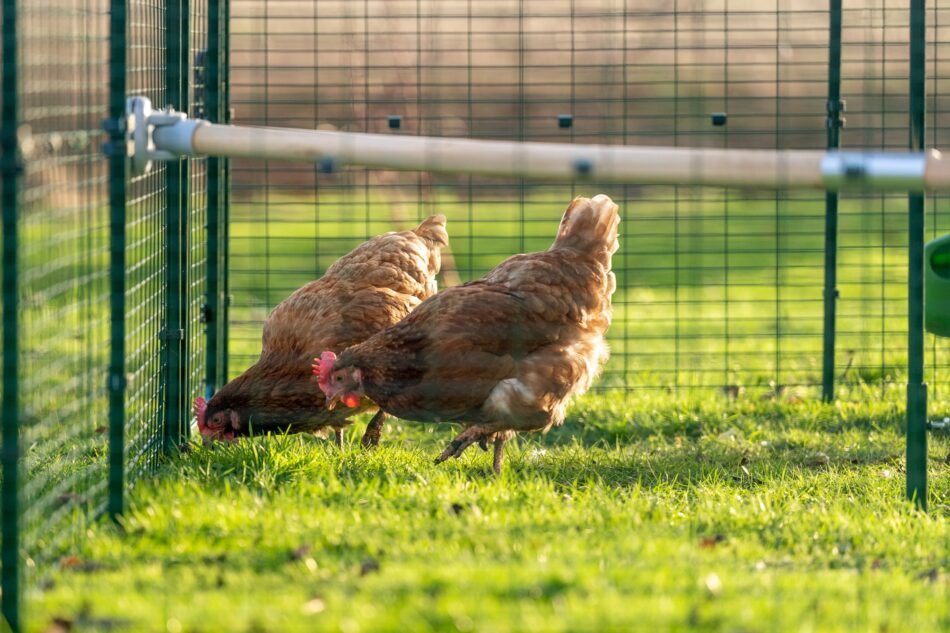
Wondering how to start keeping chickens? Chicken-keeping is an exciting endeavour for people from all walks of life, and in any location. Garden flocks are growing in popularity across the globe – winning the hearts of millions of chicken owners. Most people don’t realize that chickens are actually full of personality, can bond with their owners, and are very enjoyable as pets. They can learn basic tricks, are excellent at pest control, and make beautiful additions to gardens as living art. And, as an added bonus, hens can provide fresh eggs for your family on a daily basis.
Ready to take the plunge into keeping poultry as pets? With the right products from Omlet and some preparation, keeping chickens can be an easy and enjoyable hobby for your entire family.
Chicken-keeping basics
We’re excited to help you get started keeping chickens! And, we’re sure you have lots of questions about chickens and their care. Learning is part of the fun of keeping chickens, and we’ll provide you with the knowledge you need to be successful from the start.
Choosing the right breed
Like many pets, there are many different breeds of chickens. Some are “good layers”, meaning they produce lots of eggs, and some are “ornamental”, being prized for their unique looks and characteristics. Hens come in various sizes and colours, and most breeds get along with others should you decide to keep a mixed flock.
Starting with hens vs. chicks
Some people choose to start with adult hens rather than with young chicks. There are benefits to each, but first-time chicken keepers will likely find the most success with adult hens. When you start out with hens:
- You know the gender of your birds, whereas most breeds of chicks cannot be sexed until they’re older
- Adult hens will already be laying eggs
- Chicks require a minimum of 6-8 weeks in a special pen called a “brooder”, and must have a heat lamp or brooder plate during that time
- You can pick adult hens from a flock based on personality and colour, while chicks will take time to develop these traits
- Chicks shouldn’t be left unattended for long periods of time, such as out-of-town trips, while hens are self-sufficient when left in a secure coop and run with enough food and water
Ultimately, it’s up to you to decide if you want to start with chicks or hens. Keep in mind that chicks are heavily reliant upon their human caretakers – for everything from food, clean water, and a constant heat source. Adult hens are much more resilient and require less of your time, so if you’re completely new to chickens, it’s usually easier to start with adult hen
Lay the groundwork
Consider where you’re going to house your hens. You’ll need to find as level of a place as possible in your garden to set up their coop, and ensure that their area is free of any potentially dangerous vegetation. Chickens are marvellous insect-eaters, and will also gladly help with landscaping if left to forage around. Check to make sure your flock doesn’t have access to any plants that are toxic to chickens.
If your chickens will be in one place consistently, you’ll want to choose bedding for the base of their run. Wood chips, coarse sand, or hemp bedding can be used to line the bottom of your flock’s run to keep them out of the mud.
Use a plastic chicken coop
Now that you’ve decided on what type of chickens you want to keep and where you’d like to keep them, it’s time to get the most important piece of chicken-keeping equipment: their chicken coop.
A quality chicken coop of any type is an investment, but a plastic chicken coop will last much longer than a wooden chicken coop. Not only that, but plastic coops are immensely easier to clean than wooden coops, and require no upkeep.
Omlet’s Eglu Cube will never rot, need repainting, or re-roofing like traditional wooden coops. Plastic chicken coops are quickly replacing their wooden predecessors now that the chicken-keeping world knows not all chicken coops rot.
Most chicken keepers are not fond of coop cleaning day, but the Eglu Cube has flipped the script on this previously dreaded task. In just minutes, your Omlet chicken coop can be cleaned with minimal effort. Simply remove the bedding tray, dump into your compost or garbage, and spray the tray with a pressure washer or a chicken-safe disinfectant to wipe clean. Refresh the bedding, replace the tray, and your chickens’ coop is sparkling clean once more!
The Eglu Cube might be Omlet’s largest chicken coop, but that doesn’t mean assembling it is hard. In fact, the Eglu Cube is easy to assemble and is ready for your hens as soon as it’s put together. And, with options like wheels and handles that can be added quickly during assembly, your chickens’ coop can be fully mobile.
Invest in a sturdy chicken run
If your hens need a space to call their own, you can opt to attach a run to the Eglu Cube. Their run can be extended in increments with our Eglu Cube Run Extension Packs. Or, if your space allows, consider a Walk In Chicken Run for your flock.
All of our chicken runs have anti-dig skirting that helps prevent predators from tunnelling in, and are constructed of heavy-duty welded wire instead of flimsy mesh. Omlet chicken runs are designed to withstand the elements, predators, and weather events. Add optional chicken run covers to give your hens shelter from rain, snow, sun, and wind. Or, add a cover for your Walk In Run to fully shield your flock from the elements.
An automatic coop door is a chicken-keeper essential
One of the best things you can add to your chickens’ setup for both you and your flock is an Autodoor. This coop concierge lets your hens out in the morning and tucks them in at night – so you never have to worry about getting out of bed or being home by a certain time. And, the unique horizontal opening mechanism of the Autodoor by Omlet adds an extra layer of security to your chicken coop. Predators will be stumped by the sturdiness of our firm-sealing Autodoor.
The Autodoor can follow a schedule determined by the sun or the clock. Simply program your Autodoor on the easy-to-use control panel to follow whichever type of schedule you prefer. Multiple daylight options can be chosen, closing at or before dusk, and opening when the sun rises or shortly after. The time schedule is easy to follow, allowing you to select specific hours for the Autodoor to open and close.
Add an optional coop light to give your flock a soft glow to help them head in for bed. The coop light comes on 5 minutes before the Autodoor is scheduled to close. Chickens naturally gravitate toward light when the sun sets, so a night light helps stubborn hens in particular find their way to the roost when it’s bedtime.
Chickens need entertainment, too
Chickens are low-maintenance pets, but still enjoy entertainment. Mental and physical stimulation is great for helping your hens stay healthy and happy. Plus, added accessories make it that much more enjoyable to watch your hens play and exhibit their natural behaviours.
Let your hens play with their food
Omlet has a variety of chicken toys and accessories. Accessories like the Chicken Peck Toy are great for elevating snacktime and keeping the bottom of the run clean. Keep scratch grains and other small treats inside the peck toy to make rations go farther and reduce waste.
The Caddi Treat Holder is perfect for serving fresh veggies and leafy greens, or homemade chicken treats to your hens. Hang the Caddi Treat Holder from any run, and bring it inside to refill with your flock’s favourite treats.
Perches add levels of fun
Like most bird species, chickens enjoy perching to get a better view of the world around them. The Freestanding Chicken Perch can be placed anywhere, and is easy to move anytime. Convenient and sturdy screw pegs anchor the Freestanding Chicken Perch in the ground for stabilized perching. The screw pegs can easily be unscrewed for relocating the Freestanding Chicken Perch to keep your hens on their toes.
If you have a Walk In Chicken Run, Omlet’s PoleTree Customisable Chicken Perch is perfect for adding a variety of levels to your flock’s space. Add perches of various lengths, treat holders, and peck toys to hang from pre-drilled holes in the ends of the PoleTree’s smooth eucalyptus wood perches to customise your chickens’ experience. The PoleTree is perfect for utilizing aerial space in a Walk In Chicken Run, and adds visual appeal to create a truly unique environment for your flock.
Omlet and your chicken-keeping adventure
We want you to enjoy your chickens from the moment you bring them home and for years to come. That’s why Omlet has invented products that not only keep your flock healthy and happy, but are designed to bring you closer to your chickens. The Eglu Cube, Walk In Run, and Autodoor are all thoughtfully and purposefully crafted to keep flocks safe and content while making chicken keeping easy and enjoyable for their owners. Let Omlet help you get started on your chicken-keeping adventure, and enjoy the journey to the fullest.
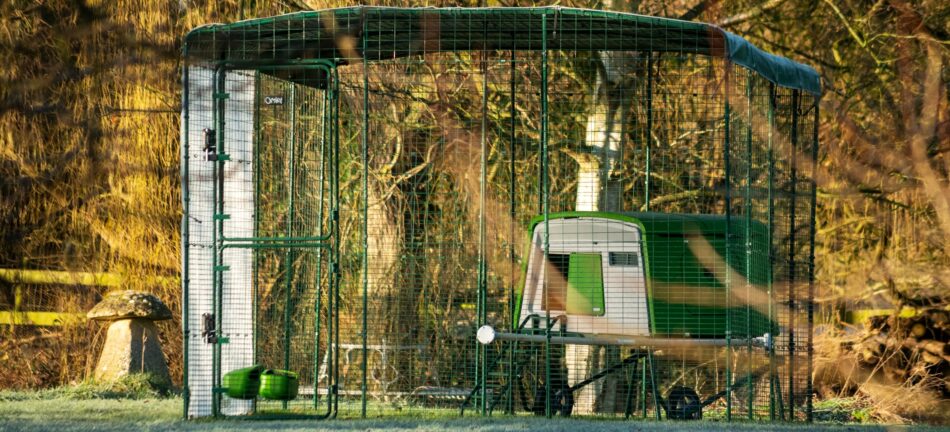
This entry was posted in Chickens
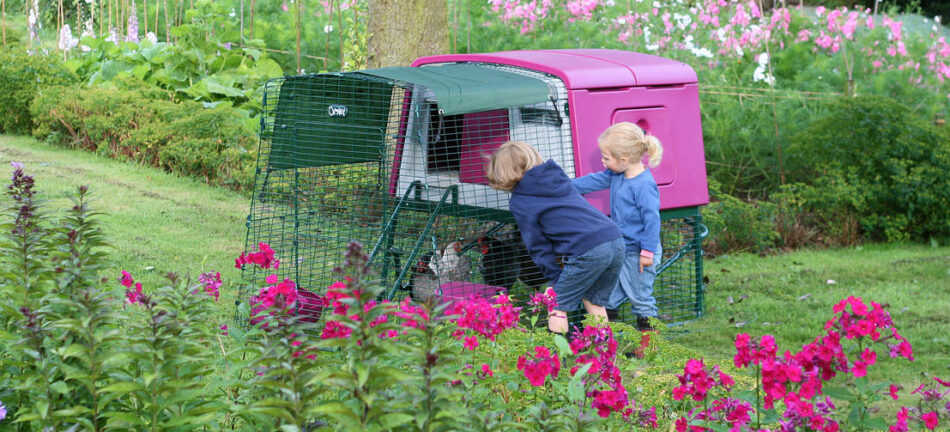
There’s a new dilemma that chicken keepers are faced with: whether to invest in a plastic or wooden chicken coop. Wooden chicken coops are common, but plastic coops are rising in popularity due to their low maintenance and ease of cleaning. Maintaining and cleaning wooden chicken coops is costly and time-consuming – but Omlet’s plastic chicken coops are saving chicken keepers both time and money.
Comparing wooden vs. plastic chicken coops
There are some major differences between wooden and plastic chicken coops. Ultimately, it comes down to which type of coop best fits your budget and lifestyle, but we’ll help you decide how to choose your chicken coop with a visual list of pros and cons for each.
Wooden chicken coops
Pros:
- Lower upfront costs
- Readily available at many chicken supply stores
- Traditional look
Cons:
- Difficult to clean thoroughly
- Absorbs moisture, which can lead to mould or mildew
- Porous, grooved surfaces attracts and harbours mites
- Drafty (particularly dangerous in the winter months)
- Requires maintenance such as repainting and roof or board repair and replacement
- Hardware cloth or chicken wire is stapled into the wood, which loosens over time, making it easier for predators to push their way in
- Difficult to move once in place

Pros:
- Easy to clean
- Waterproof
- Twin-insulated to keep your chickens cool in summer and warm in winter
- Draft-free ventilation that keeps humidity levels down inside the coop
- Inhospitable environment for mites to thrive
- Zero maintenance required
- Doors that are easy for humans to open, but difficult for predators to infiltrate
- Attached chicken runs are made from welded wire mesh connected by heavy-duty clips
- Bold, modern look
- Easily moved with added wheels and handles
- An all-in-one chicken coop, designed to last a lifetime
Cons:
Moving your coop
At some point, you may want to relocate your chicken coop. It may be to a new spot in your garden, out of necessity for safety, or when moving to a new home. Wooden chicken coops are difficult to move once they’ve been constructed, and often are too heavy to move efficiently without taking them apart. Commercially bought wooden coops are often constructed from tongue and groove planks, which do not hold up when moved.
Omlet’s mobile chicken coops can be moved easily by one person with the use of integrated handles and wheels. This is particularly helpful in areas that experience severe weather such as tornadoes, hurricanes, or flash flooding when notice is often in short supply.
Chicken tractors enable you to give your chickens a new patch of grass to forage through, or relocate your flock should the need arise. Simply engage the wheels, then use the handles to push or pull your hens’ home to a new spot. Disengage the wheels, and your hens are ready to peck their way through their new turf – without ever having to leave their run!
Customizing your chicken coop
Plastic chicken coops offer customization options that wooden chicken coops simply can’t. Additions of walk in chicken runs can expand your flock’s space and can continue to expand along with the number of chickens you have. You can also automate your chickens’ schedule by installing an automatic chicken coop door.
These accessories can be added to a wooden chicken coop, but the structural integrity of wooden coops becomes compromised after time in the elements, making them a less-than-perfect match. A plastic chicken coop designed to last a lifetime is not limited to a short timeframe for upgrades and customization.
Coop cleanliness
It’s important to regularly clean your chicken coop – no matter the material. Chickens themselves don’t smell, but their droppings do! Coops that aren’t clean attract flies and other pests that affect both you and your flock, and harbour bacteria that can bring harm to your flock.
Wooden coops need to be washed, but wood is porous and difficult to clean. Droppings usually need to be scraped off with a putty knife, with surfaces then sprayed with a chicken-safe disinfectant. Because wood absorbs moisture, you’ll need to allow ample drying time for any products or water applied to a wooden coop. Once dry, wooden coops need to be treated for mites after each cleaning with chicken-safe antiparasitic sprays or powders.
Plastic chicken coops can be deep cleaned quickly and easily. Omlet’s plastic chicken coops have removable roosting racks and droppings trays that can be pressure washed along with the entire interior. No antiparasitic treatment is needed after a plastic chicken coop has been pressure washed and wiped clean.
Predator resistance
Chicken predators are a danger that every flock raiser will encounter at some point. The sounds your hens make attract predators, as do the rodents that try to steal a snack from your chicken feeders.
Wooden chicken coops usually have hardware cloth stapled around the inside of any openings. However, wood gets weaker the longer it stays in the elements, so the staples are easily pushed out of the wood from an outside force. Hardware cloth or chicken wire also rusts and weakens over time, making it prone to breaking under stress. Some wooden coops also have tops that open on hinges for you to access your hens or eggs. The problem is that predators (especially crafty ones like racoons or foxes) can lift any unlatched openings to access your hens themselves.
Omlet’s plastic hen houses have latching doors that are difficult for predators to open. They also have solid, heavy-duty walls with no wire to push in or break. Plastic is more resilient to the elements, so there’s no concern for warping or weakening over time. The attached chicken runs that are available with all of Omlet’s chicken coops are made of welded wire mesh that is treated against the elements. This heavy-duty wire does not weaken in the elements, with the panels being held together by our ingenious weather-resistant clips.
Insulation & performance in extreme weather
Chickens thrive in many environments, but the more assistance they get to regulate their temperatures, the better they weather the seasons. Heat stroke and frostbite can easily plague chickens that are kept in under-insulated coops. Depending on your climate, your main concern will be to either ensure your hens don’t get too hot in the summer or have chilly chickens in the winter.
Wooden coops need additional layers to offer sufficient insulation. Adding another wall with insulation in between can achieve this effect, taking care to allow for ventilation. Ventilation is key when keeping a chicken coop at a comfortable temperature and humidity level. Too much ventilation will allow insulated air to escape, making the coop too hot or too cold. On the other hand, too little ventilation causes moisture to build up, creating a damp, stuffy, overly warm coop.
Superior ventilation and insulation is found in Omlet’s plastic chicken coops. The twin walls trap a pocket of air (the best insulator) around the coop to help keep the temperature at a comfortable level. Mindfully placed ventilation points allow for just the right amount of air to circulate even when the coop door is closed. This reduces the humidity level in the coop and allows for fresh air to circulate.
Additional extreme weather protection for your hens can be added to Omlet chicken coops. This cold weather preparation for chickens helps your coop stay as warm as possible in the winter.
Durability – how long will a coop last?
The elements are not kind to wooden chicken coops. Harsh UV rays, soaking rains, heavy snow, and high winds all wreak havoc on traditional chicken coops. Wooden chicken coops maintain their integrity for the first few seasons, but soon you’ll notice the beginning stages of the deterioration process.
Rotting or weakening wood, faded paint, and missing roof shingles are usually the first elements of a wooden coop that fall prey to the weather. Replacing any weak planks and repainting or retreating boards with weather-resistant paint is an annual affair. Shingles can be reapplied to roofs, but it’s a sticky and time-consuming task!
Choosing a chicken coop that fits your budget is important, so keep in mind the long-term expenses that a wooden chicken coop will inevitably incur. A plastic chicken coop may cost more in the beginning but will save countless hours and dollars over the years, as they do not require maintenance.
Additionally, Omlet chicken coops are strong. So strong in fact, that real-life Omlet customers have shared stories of their coops surviving hurricanes, tornadoes, falling trees – and even the full weight of a bear! Heavy-duty plastic lasts for years, and you’ll never need to worry about rotting or weakening parts. The only maintenance needed on an Omlet chicken coop is regular cleaning and ensuring that the ground beneath the coop has not shifted to create gaps or misaligned doors.
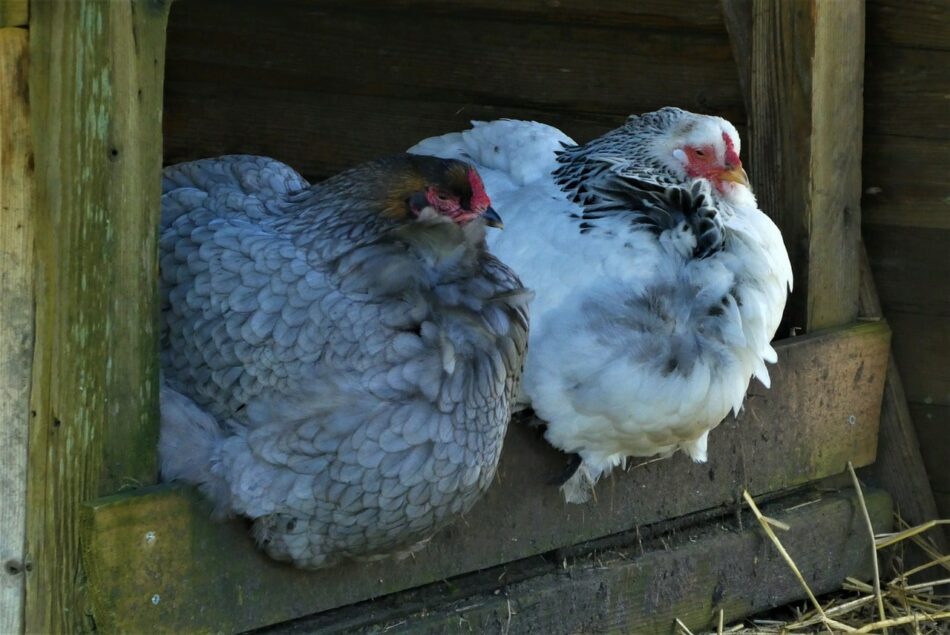
Ease of building
Building a wooden chicken coop from scratch is a daunting task! Like any carpentry work, it must be squared off, level, and properly constructed. The supply list alone will have you making several trips to various hardware stores! How nice would it be to have everything come inside of a box, requiring only a screwdriver to assemble?
Deciding to buy or build a chicken coop relies heavily on your experience. Chicken coops (or any other animal enclosure) are not a project for beginners! Your flock’s comfort and safety depend on the design of their coop.
Thankfully, assembling an Omlet chicken coop can be done in just a few hours. Our step-by-step videos make assembly easy and enjoyable. All you’ll need is a level space and a screwdriver. Your children can even help build an Omlet coop, which will help include them in your family’s flock-raising journey.
Is a plastic or wooden chicken coop best for me & my flock?
Maybe you’re already the owner of a wooden chicken coop and thinking about upgrading to a plastic coop. Is it really worth all of the fuss? Check with your hens to see! Are your chickens happy in their wooden coop?
Unless you are meticulous with repairs and maintenance on a wooden chicken coop, your chickens would probably be happier in a plastic coop. The increased security, ventilation, insulation, and ease of cleaning that plastic coops have to offer make keeping chickens much more enjoyable. So ask yourself: are you happy with your chickens’ wooden coop? If the answer is “no”, then it’s time to upgrade to plastic!
Omlet’s easy maintenance plastic chicken coops
Omlet has a variety of high-quality plastic chicken coops to fit your flock and family’s needs. From the original Eglu Go, to our largest coop yet – the Eglu Cube, there’s a coop for everyone.
Reasons to choose a chicken coop from Omlet:
- Easy to clean, move, and customize
- Superior safety, insulation, and ventilation
- Weatherproof and predator-resistant
- Excellent customer service
- Backed by a 2-year warranty
Thousands of chicken keepers have experienced the ease of owning hens with an Omlet chicken coop. In fact, you can reach out to a local Omlet ambassador to ask them about their experience, and see their setup for yourself.
See the Omlet difference
We’ve invented coops that bring joy to chicken ownership. Keeping chickens shouldn’t be a chore – it should be a relaxing and rewarding hobby. Once you’ve decided on an Omlet chicken coop, explore our other products that are designed to complement to your coop, such as:
As always, our team of experts are ready to help you decide which coop is right for you and your flock, and to support your entire chicken-keeping journey.

This entry was posted in Chickens
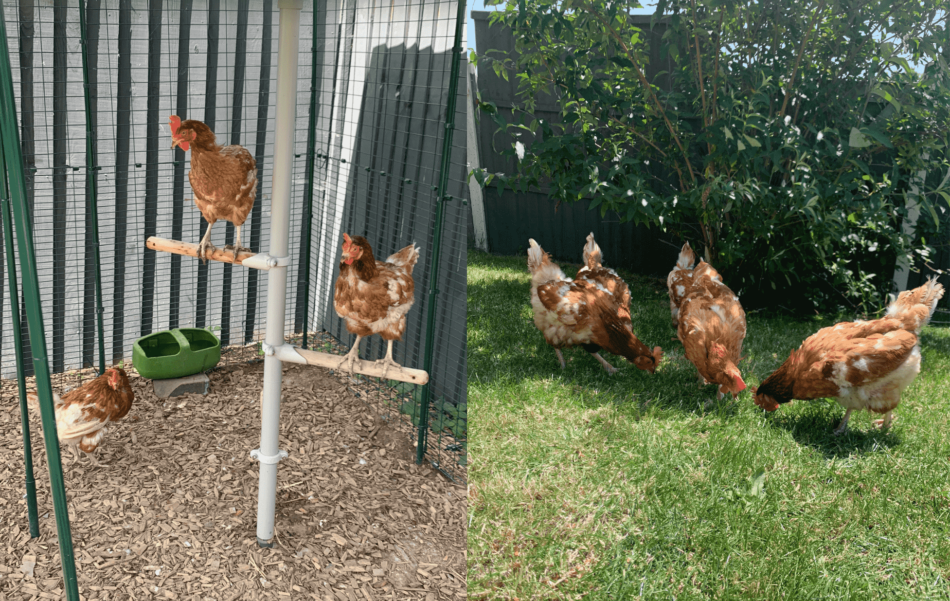
Around the 1930s, battery cages, or small wire frame cages, were introduced as a way to increase egg production from hens on an industrial scale. Female chickens are placed in these cages from the time they hatch until full egg-laying maturity, which is typically considered 18 months.
While many countries including the UK have banned or are phasing out the use of conventional battery cages, there are still many countries such as the U.S., where they remain legal. Because ex-battery hens have a lower egg production, many groups look to rescue them to provide a new home for these still full-of-life (and eggs) birds.
Most ex-battery hens require a little bit more attention and care during the first few months as they have to adjust to a new (and much better) life than what they previously knew. But just like any animal rescue, with some patience and extra love, they will quickly settle into their new routine and enjoyment of life. Here is how you can create the perfect setup for your ex-battery hens.
The Omlet Eglu Cube Chicken Coop
Ex-battery hens only know the confines of a small cage for their entire life until rehomed. So when creating a new space for them, consider their immediate needs of security, safety, and exploration. The Omlet Eglu Cube Chicken Coop is the perfect choice as it not only offers all of that, but is also super easy to assemble, carefully designed, and virtually maintenance-free.
In Rosie’s Chicken Keeping Adventure blog series, she shared her story of being a first-time owner of ex-battery hens. After rescuing 5 ex-caged hens of her own, Rosie decided on the Eglu Cube Chicken Coop as the new home for her flock because of the peace of mind it provided. Here are some of the features that made this product priceless for her hens, as well as herself.
- Predator resistant: Unlike free-range hens who have known life outside of a cage, ex-battery hens take a little more time adjusting to their new, more spacious, surroundings. As a result, it’s important that for whatever chicken coop you decide on, it is constructed with security and strength to keep out unwanted visitors.
The Eglu Cube is made with durable and predator-resistant hard plastic which is placed on a heavy-duty steel frame. Eglu Coops and runs have been keeping hens all across the globe safe for over 15 years and your ex-battery hens will be no exception.
- Plenty of space: Imagine living in a tiny studio apartment for your whole life only to be moved to a luxurious and spacious mansion….it’s a similar feeling for ex-battery hens who are rehomed to an Eglu Cube. At Omlet, our goal is to make chicken keeping simple and fun with practicality and efficiency in mind. Plus, we know just how important space and exploration is to chickens.
The run that comes with the Eglu Cube is expertly designed to create a full-on henertaining playground for your chickens. And thanks to its modular design, you can very easily expand your run and walk-in chicken run that allow you to grow with your flock.
- Private nesting box: Battery-caged hens are stripped of many animal privileges, not the least of which is the ability to nest, or lay eggs, in private. Nesting is a natural instinct for chickens and something that ex-battery hens will quickly embrace once rehomed in an Eglu Cube.
The Eglu Cube’s private nesting box comfortably fits up to 3 egg-laying hens at a time. Collecting fresh eggs from your coop is definitely one of the greatest perks of being a chicken keeper, but for ex-battery hens, it’s literally a new leash on life that they are given with this space.
More Omlet chicken essentials
Once your ex-battery hens have adjusted to their new life in their Eglu Cube home, you can really start to customise their space. We have endless options for you to create the ultimate hen home and we know first-hand that ex-battery hens will love them all.
Omlet Chicken Fencing: No matter the size of your garden, you can still increase the exploring space for your hens. Chicken fencing is the perfect way to allow your chickens free roam in the garden with risk of escape. Our chicken fencing is not only easy to install with a tangle-free design, but the dark colour blends in neatly with your garden.
Chicken PoleTree: Now the fun begins! Our fully customisable PoleTree is truly any chicken’s dream. Create a fun and engaging communal playground for your entire flock as your hens enjoy the stimulation and ability to check out new heights. You can install the tree in any walk-in chicken enclosure and know that it is sturdy and strong to hold several chickens at once. And don’t forget to add a chicken swing so your feathered friends can truly make the most of their new lifestyle.
Automatic Chicken Coop Door: Our priority with our chicken products is safety with simplicity and that is precisely why we created the Universal Automatic Chicken Coop Door. Compatible with any wooden coop as well as the Eglu Cube, this is the safest and most convenient way to let your chickens in and out of the coop. Battery-powered with the option to operate on a timer or sensor, this door will not only guarantee all hens are home safe at night, but it will also keep your chickens protected from any weather elements with the added insulation of a closed door – even if you’re not yet home.
How you can help ex-battery hens
The number one way you can help ex-battery hens is by adopting them and giving them a new home of their own! But how do you do that? The BHWT (British Hen Welfare Trust) are committed to advocating for these hens and giving them a second chance at life. Their mission is simple – rescue and rehome ex-battery hens as pets.
There is no better reward than to give an ex-battery hen a new home – for you and your new feathered friend. With an easy set-up like the Omlet Eglu Cube, your hens will live out the rest of their days in peace, comfort, and joy. And as their chicken keeper, you will wonder how you ever lived without them in the first place.

This entry was posted in Chickens
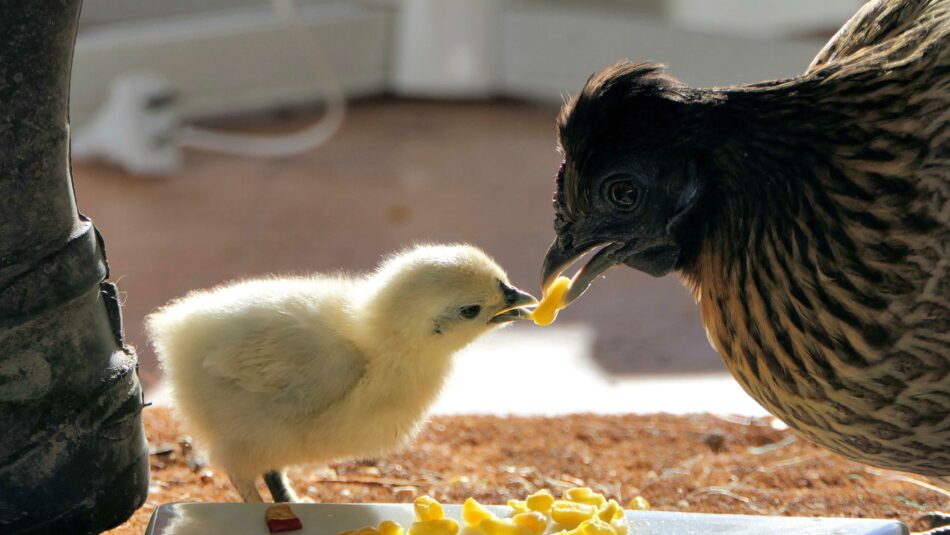
If you’re raising a flock from chicks, you’ll want to be able to recognize the stages of raising chickens. Chickens will go through several stages throughout their journey from egg to adult, and each stage has different care requirements. Knowing how to care for your chickens during each phase of their growth will help foster the bond between you and your flock, and ensure that they are healthy and thriving.
Determining the age of a chicken
If you haven’t hatched your chickens from eggs, you may be unsure of their age when you bring them home. There are a few ways to help you determine how old your chickens are:
- Downy feathers: if your chicks are still fuzzy or fluffy in appearance, they are less than 5 weeks old.
- Adult feathers: between 5 and 6 weeks, with the majority of breeds becoming fully feathered by 6-8 weeks of age.
- Laying eggs: at least 16 weeks old
Chickens that are at least 12 weeks old are ready for their permanent homes in their comfy chicken coop and spacious chicken run. It’s important not to introduce them to a raised coop until they are at least 12 weeks old, as younger chicks don’t have the coordination or size to navigate a ladder.
Stage 1: hatching eggs
The best way to determine the age of your chickens is to hatch chicks from eggs. This is actually a relatively quick and easy process once you have the right equipment. It’s a wonder-filled educational experience for children, and when timed right, you can even witness your chicks hatching from their eggs.
Things you’ll need to hatch your own eggs:
- A quality incubator, with or without an automatic egg turner (if you don’t have a turner, you’ll need to rotate the eggs 3-5 times within a 24-hour period)
- A thermometer and hygrometer (if not included with your incubator)
- A calendar
- Fertilized chicken eggs
- Optional: an egg candler to document embryo development
Even if your incubator has an auto-turner, it’s a good idea to mark eggs with a pencil to make sure your incubator is turning your eggs properly. Fertilized chicken eggs can be purchased from farms or breeders, or if you have a male chicken, you can collect your own eggs to incubate. It’s important to keep in mind that fertilized chicken eggs have variable hatching success rates. Not all eggs will develop and hatch, even if conditions are just right. To ensure the highest hatch rate, follow the instructions that come with your incubator as closely as possible. If you want to candle eggs to view the developing chick, open and close the incubator as quickly as possible so as to not disrupt the internal temperature and humidity level.
After 21 days of incubating chicken eggs, your chicks should start hatching. You’ll want to “lock down” your incubator by following its instructions during the last few days of incubation. Usually, you’ll add more water to increase humidity levels, lower the temperature slightly, remove the auto-turner (if applicable) and place a non-slip surface under the eggs so newly hatched chicks can get their footing. If you want to watch your chicks emerge from their eggs, watch for “pipping” in the shells of the eggs. A chick will pip (make a tiny hole) in the shell of its egg within 24 hours of hatching. Some chicks progress quickly through the hatching process, while others take the full 24 hours. If you notice a pip in an egg, it’s best to stay close if you don’t want to miss seeing your chick hatch!
Stage 2: young chicks
Store or breeder-bought chicks can be purchased as straight runs (non-sexed) or as pullets (determined to be hens). Straight-run chicks can be purchased as early as 1 or 2 days after hatching, while pullets are a little older. Sexing chicks under 8 weeks old (and even older for some breeds) isn’t 100% reliable, but your odds of getting a cockerel when purchasing sexed chicks are greatly reduced. Some breeders will even offer to swap out any cockerel that were mistakenly sexed for pullets.
All chicks will need a heat lamp and a brooder pen until at least 6 weeks of age. Make sure to have a brooder pen completely set up before bringing your chicks home to avoid common mistakes when raising chickens. Things you’ll need for your brooder include:
- A sturdy enclosure with solid walls, and preferably a top to keep older chicks in and other animals or objects out
- A heat lamp
- Absorbent bedding, such as pine pellets or shavings
- Chick crumble feed
- A chick-safe waterer (a shallow, gravity-fed waterer is best)
- Chick grit to promote healthy digestion
- A thermometer to attach to the side of the brooder to monitor temperature
Chicks that have not been vaccinated for coccidiosis by a breeder will benefit from being fed medicated feed for the first 2-4 weeks of life. After that, they can transition to non-medicated chick crumbles.
At 6 weeks old, most breeds of chicks will be fully feathered with their adult plumage and ready to venture outdoors. Start with short visits in an area enclosed by chicken fencing, making sure to supervise them the entire time. You can also start introducing them to their coop and run during their outdoor visits to get them accustomed to their forever home.
Stage 3: pullets & cockerels
Once chicks reach 5-7 weeks old, most breeds exhibit differences in appearance between pullets and cockerels. You may find it useful to take a look at the Omlet Chicken Glossary for further information on this subject as depending on where you’re from, you may have heard young male birds be referred to as cockerels, and fully grown male birds as roosters.
Now in their awkward teenage stage of growth, pullets and cockerels will begin growing their secondary feathers and exhibiting signs of their respective genders. Cockerels will usually be larger in size and have combs and wattles that are more developed and pronounced than pullets. Pullets will generally have longer flight feathers (the secondary feathers starting mid-wing and extending to the tip), while cockerels will have longer tail feathers. Cockerels will begin to attempt crowing around 6-8 weeks of age, and is the most definitive way to determine their sex.
Young hens are referred to as pullets until around 20 weeks of age, while cockerel is a term used for cocks under 1 year of age. But regardless of gender, your young chickens will need the same care. Pullets will begin laying eggs as early as 18 weeks of age, and will need to be fed laying crumbles or pellets by this time. Cockerels can eat the same diet as your pullets.
Housing requirements are the same for pullets and cockerels, as all chickens need safe spaces to roost, play, and forage. A walk in chicken run is the best option for all flocks, as it allows for plenty of space, and gives keepers an opportunity to join their chickens. All chicken pens should be predator-resistant to protect your flock from chicken predators. Your chicken coop should be able to keep your chickens comfortable all year round, easy for you to clean, and offer a safe place for your flock to roost at night. The Eglu Cube Chicken Coop checks all of these boxes for flocks of up to 10 small breed chickens.
Stage 4: Mature chickens
Once your chickens are fully matured, they’ll start being referred to as hens and cocks. With a few exceptions (such as Silkie chickens, who take longer to mature), the differences between male and female chickens include:
- More pronounced combs and wattles
- Longer tail feathers
- The presence of “spurs” (bony, keratin-covered protrusions on the inside of their legs)
- Crowing
Hens and cocks can usually cohabitate just fine, but it’s important to not have more than one in your flock. If more than one is kept in the same coop and run, fights are bound to occur. You may also notice your hens losing feathers on their neck, back, or under their tails from too much attention. If this happens, separate the cock from your hens until they recover. If this occurs regularly, you may need to find other permanent arrangements for your male bird.
The presence of a cock is not necessary for egg production. Laying hens will typically produce one egg every day and a half. High egg-producing breeds can lay over 300 eggs per year. Having a safe hen house will give your hens a comfortable space to lay their eggs, which is essential for egg production. You can also encourage your hens to lay more eggs by supplementing their diet – particularly in the winter.
Stage 5: retirement from laying
While most breeds of chickens have a lifespan of 8-10 years, their fertile, egg-producing years stop short of this mark. By the time a hen is 5 or 6 years of age, egg production will have drastically slowed or come to a complete halt. Hens that are well cared for will act and appear the same as in their younger days, but you may notice subtle differences such as:
- Moving more stiffly or slowly
- A thickening in the bottoms of their feet
- Fewer eggs, but larger in size
- Moving down in the flock’s pecking order
With the absence of additional female hormones, an ageing hen may even acquire traits that are usually unique to male birds, such as growing spurs, larger combs or wattles, or even start crowing! This phenomenon is rare, but is not indicative of health issues in an older hen.
4 tips for first-time chicken-keepers
The most important thing to consider when getting chickens for the first time is to evaluate how much time and space you have to dedicate to raising them. If you have an enclosed area such as a shop or a barn to set up a brooder pen, then incubating or purchasing young chicks can be a rewarding experience. Or, if you’re ready to put chickens into a coop and run and collect eggs right away, then getting adult chickens would be the better option.
Whichever you choose, here are 4 tips to remember when getting chickens for the first time:
- Perform your research ahead of time. Decide on which chicken breed(s) you want, how many, and if you want only hens.
- Have all of your equipment set up and ready to go. Get to know your incubator and brooder (if applicable), coop, and run to ensure that everything is set up and working properly.
- Find support. No chicken keeper has everything figured out, but many have improved their experience through trial and error, and will have invaluable knowledge as a result.
- Have fun, and maintain a sense of humour! Chickens are enjoyable pets, so be sure to bask in the relaxing days, and keep your head up during the (rare) stressful days.
Caring for your chickens at every stage with Omlet
Omlet has products to support your chicken-keeping journey at every stage. Keeping chickens is a hobby and lifestyle for many people, and can be enjoyed by every member of the family. With flexible options like a chicken tractor, you’ll be able to move your flock around your garden or property with ease. Or, if it’s a more permanent setup you’re after, our large chicken coop can be integrated with our walk in chicken run for the ultimate safe play space.
Make your flock’s setup your own with accessories like chicken perches, a chicken swing, or a chicken toy starter bundle. These accessories can be enjoyed by chickens of all stages: from chicks up to retired hens. And, you’ll be able to enjoy watching your flock foster their natural instincts in these creative ways.
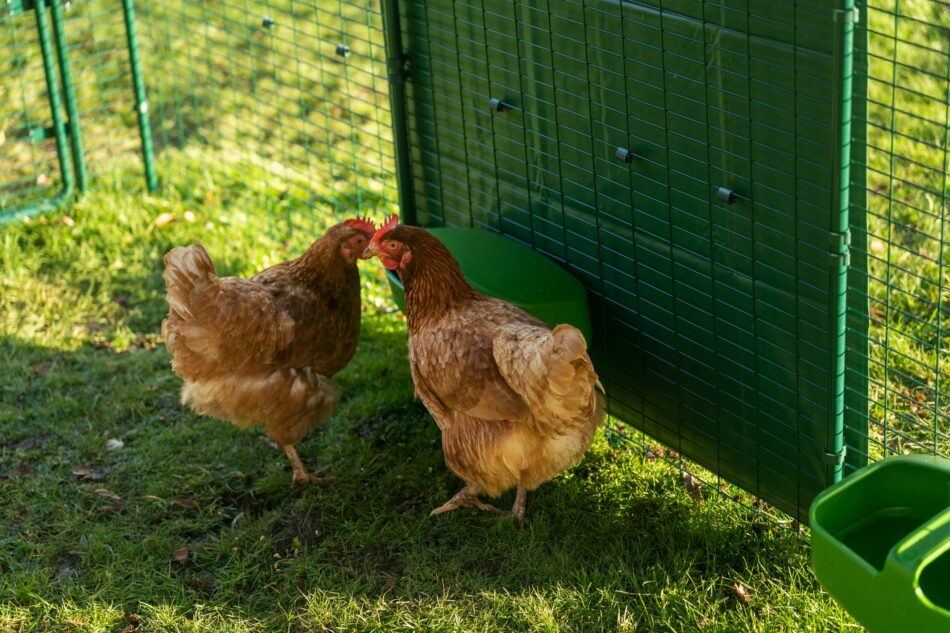
This entry was posted in Chickens

Wondering what the benefits of a chicken tractor are? The term may or may not be familiar to you, so you might be wondering: what exactly is a chicken tractor?
Chicken tractors are great for adding diversity to your flock and your garden. They also make it possible to move your hens quickly and safely, which is appealing to those that live in areas that experience severe weather events.
Omlet offers easy-to-assemble chicken tractors that are perfect for garden flocks. Does the ability to move your flock appeal to you? Let’s take a look at chicken tractors, and how they can benefit flock raisers.
What is a chicken tractor?
Chicken tractors are floorless, mobile chicken coops, with or without wheels. The idea began when farmers wanted to raise meat chickens on pasture, but without the risks that free-ranging can bring. The result was the “chicken tractor”, so named because the animals contained within it churn the ground much like a tractor would. There are “tractors” for multiple species of farm animals, such as rabbits, poultry, and pigs. The effect was two-fold: pasture-raised animals produce higher quality meat than those raised in a barn or coop, and areas of dense vegetation could be mowed down by animals inside of the tractor.
This method has practical applications for garden flock raisers that keep laying hens as well. Fresh grass, vegetation, and insects that hens ingest while foraging outside of their coop offer great nutritional value to their diet. In turn, some of these nutrients pass through to their eggs, making them healthier for you!
Reasons to get a chicken tractor
Aside from adding supplemental nutrition to your flock’s diet, keeping your flock in a chicken tractor has other benefits.
- Chicken tractors are easily moved, allowing you to relocate your coop whenever you’d like
- Mobile chicken coops can be moved in preparation for severe weather, changes in the seasons, or to help with landscaping
- Relocate your coop easily if you move, or if you have a small garden that would benefit from rotating your hens’ area
Chicken tractors for flocks of laying hens can be very practical, depending on your routine and space. A chicken tractor from Omlet can also be attached to chicken runs later for a more permanent chicken coop setup, making them a flexible and customizable option.
What’s the best chicken tractor for my hens?
Omlet chicken tractors come in different sizes and configurations. The Eglu Cube Chicken Coop configured as a mobile coop has an attached run with added wheels and handles. Our largest coop, the Eglu Cube is the best choice for larger flocks of 4 hens or more. Despite its ample size, the Eglu Cube chicken tractor can be moved easily by just one person. The raised coop offers extra pecking space below, as well as a shady area for your hens to get relief from the sun.
The Eglu Go Up Chicken Coop is a more compact version of the Eglu Cube. Best for flocks of up to 4 hens, the Eglu Go Up offers elevation to make coop cleaning and egg collecting easy. This smaller chicken tractor is perfect for children to help clean and move around.
Lastly, the Eglu Go Chicken Coop is a ground-level chicken coop that can be configured with handles and wheels to be converted into a chicken tractor. Some breeds of chickens (or individual hens) prefer roosting on the ground, making the Eglu Go an ideal choice.
What to expect the first time keeping chickens
- Lean into the first-time chicken-keeping angle, as many people looking at the benefits of a chicken tractor will be in the research phase before taking the leap.
- Consider presenting the types of thing people should expect from their first flock, and what they should have to be prepared for them.
How often to move your mobile coop
When to move your chicken tractor depends on a few factors. Chickens don’t just eat the bugs found in the grass – they actually eat the grass as well. The best method for deciding when to relocate your chicken coop is by observing the grass. Once your hens have mowed it down, it’s time to move to a new patch. It’s entirely possible to have your hens mow your entire garden by rotating them in a pattern.
It’s also helpful to move your mobile chicken coop to sunnier areas in the winter, or to shady areas in the summer. In the case of severe weather, a chicken tractor can also be moved quickly to a secondary shelter, or out from under trees to avoid potential falling limbs.
Can I move my tractor with the chickens inside?
Keeping your chickens inside your chicken tractor while moving it is dependent on their personalities and your terrain. Some hens may be content to go along for the ride when being relocated, while others may be alarmed. If your garden is relatively flat, the gap created along the bottom from engaging the wheels of the chicken tractor should not be large enough for hens to escape through. However, a panicked hen may attempt to squeeze through small spaces.
Test your flock’s reaction and build their confidence by moving your chicken tractor by just a few inches at a time. After some practice, you’ll likely be able to keep your hens inside while your mobile coop is being relocated. If your property isn’t flat, or if your flock is upset by being moved around, you’ll need to relocate your hens to a chicken pen during moves.
Tips to make your flock love their chicken tractor
Chicken tractors can be customized just like their stationary counterparts. Chicken toys and accessories or a chicken swing are perfect for adding height and enrichment to your hens’ environment. Simply add these entertaining pieces to the attached run of your chicken tractor, and enjoy watching your hens peck the ground and play in their personalized space.
Freedom with Omlet
Omlet believes in letting chickens live their best, most natural lives while being protected. Our chicken tractors have all of the features of our stationary coops, with the added convenience of being mobile. Flexibility in chicken keeping has never been easier than with Omlet’s mobile chicken coops. Combine our chicken tractor with chicken fencing to create custom boundaries for your chickens, and add chicken treats to your routine to deepen the bond between you and your flock.

This entry was posted in Chickens
















































